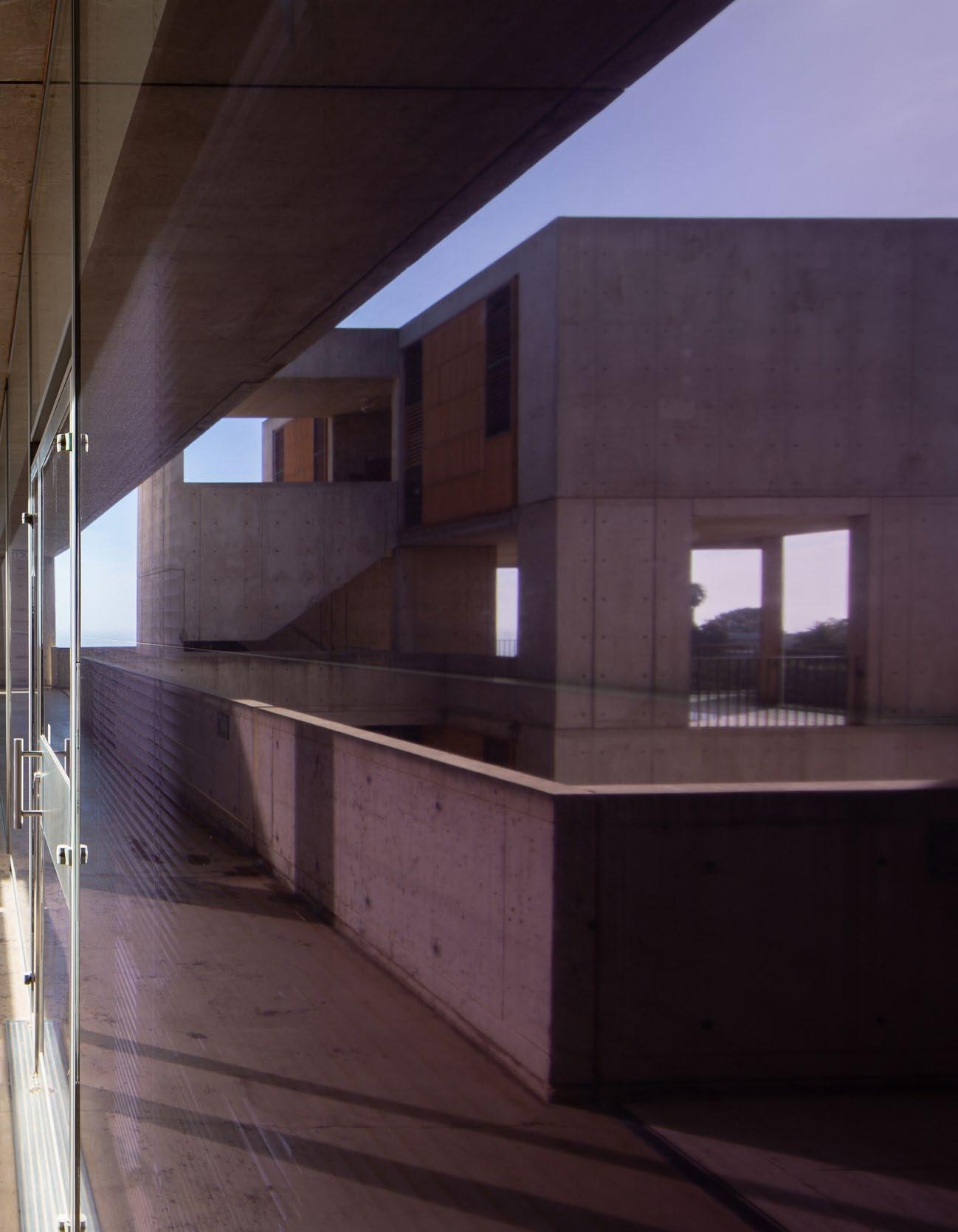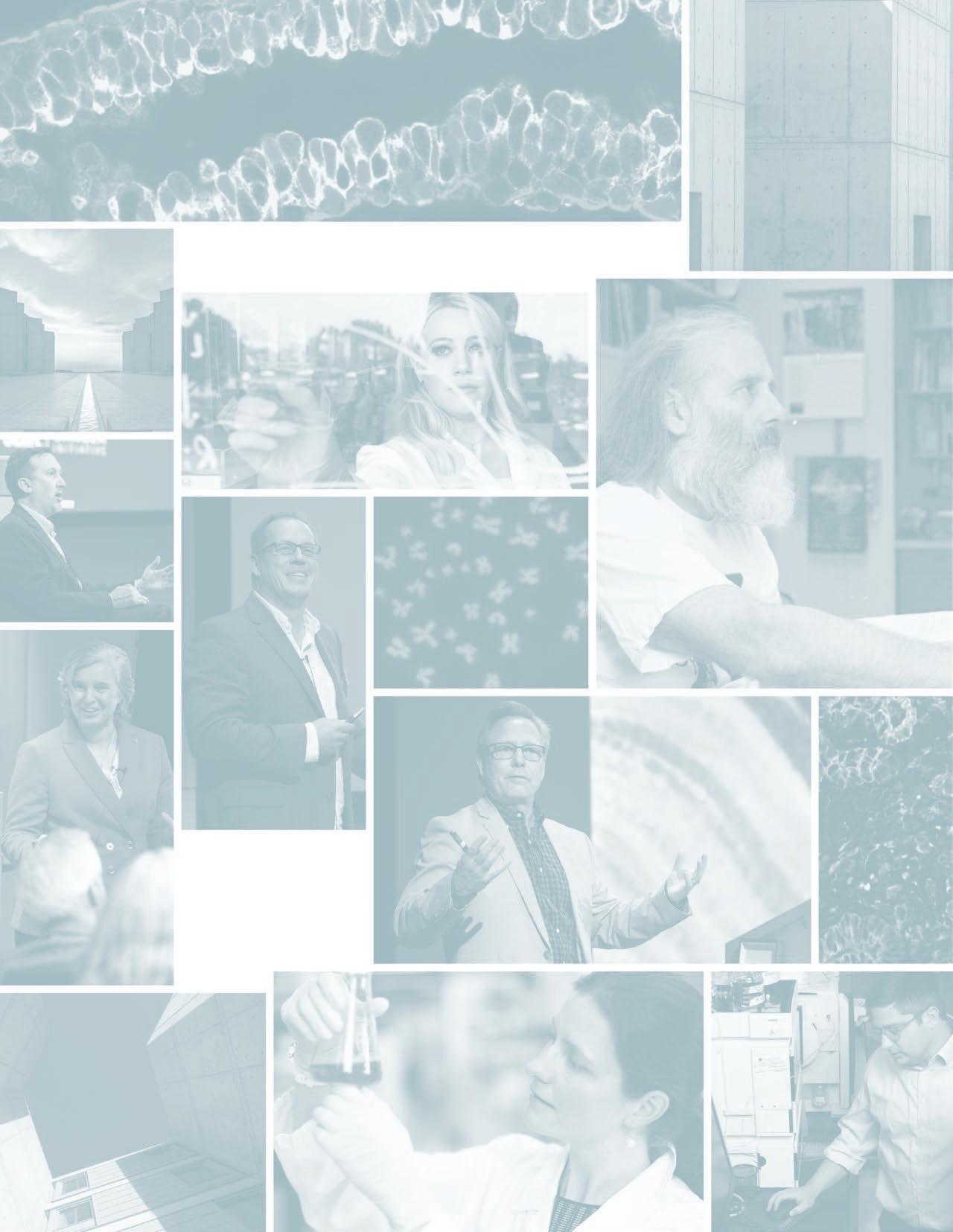




After an extensive six-month search, I was delighted to announce in February that Jerry Joyce, who has served as Salk’s senior vice president and chief science officer since July 2022, will become the Institute’s next president on April 21. Jerry succeeds Rusty Gage, who will return to his lab full time after leading Salk through a truly transformative period during his five-year tenure.
Given Jerry’s longtime connection to the Institute and exceptional resumé, he was a natural leader to consider among a large pool of excellent contenders during this search. But this decision was not about the past, nor about legacy or pedigree. What distinguished Jerry’s candidacy was his insightfulness, creativity, enthusiasm, and inspiring vision for Salk’s future—a forward-looking outlook for scientific opportunity; a strengthened financial foundation via a successfully executed comprehensive fundraising campaign; a deep commitment to prioritizing open communication; and dedication to active diversity efforts to ensure all in our community feel welcome, engaged, supported, and recognized. I invite you to read more about Jerry on page 4 and hope you will join me in congratulating him on this new role.
We plan to initiate an international search for our next chief science officer to build on this momentum. In the interim, Professor Greg Lemke, a three-time Academic Council chair, has graciously agreed to defer his retirement and extend his considerable service to our Institute when Jerry assumes the presidency. We are very grateful to Greg.
As Salk enters this next exciting chapter, we are well-positioned to advance our vital mission thanks to Rusty’s leadership. Having assumed this role at a time of significant challenges, his momentous impact on the Institute—culturally, organizationally, and scientifically—is immeasurable. Salk today stands tall as a unified, inclusive community that confidently stakes its claim as a coveted destination for the world’s top scientific talent—those here now and the many more to come—who aspire to devote their life’s work to the betterment of humanity through the power of scientific discovery.
In addition to welcoming a new president and interim chief science officer, we are also celebrating the 50th anniversary of our Cancer Center’s special National Cancer Institute designation. In this issue of Inside Salk, you’ll discover how Salk’s Cancer Center became an international powerhouse, generating numerous fundamental discoveries that have become paradigms in cell and cancer biology and led to new treatments for patients.
Additionally, Professor Reuben Shaw, director of the Salk’s Cancer Center, shares his personal and scientific journey. Leona Flores describes how she went from admiring Salk’s concrete design as an architectural engineering student to—years later—leading the Cancer Center’s administration. Postdoctoral Researcher Payel Mondal shares her work to uncover new biomarkers that may spur the development of more-effective cancer treatments.
As you will read in this issue, exciting things are on the horizon for Salk and our science, thanks in large part to your continued support. I want to take the opportunity to again thank you for your partnership and loyalty. Together, we will change the world for the better.
Sincerely,
Marna C. Whittington Chair, Board of Trustees
“Salk today stands tall as a unified, inclusive community that confidently stakes its claim as a coveted destination for the world’s top scientific talent— those here now and the many more to come—who aspire to devote their life’s work to the betterment of humanity through the power of scientific discovery.”

With mixed emotions, I write to you one final time as Salk’s president. The past five years serving this world-renowned institute have been filled with some of the most rewarding times and some of the biggest challenges I’ve experienced in my career. I’m incredibly proud of all the accomplishments our faculty and staff made during my tenure, helping to push the Institute forward into a new era of scientific research, while honoring the legacy of Jonas Salk.
As I reflect on my time as president, I am filled with gratitude for the opportunity to work with such an exceptional group of individuals. The progress we have made together in advancing Salk’s mission and goals is truly gratifying.
Despite a global pandemic, we achieved significant milestones in our efforts to advance scientific research and discovery—from breakthrough discoveries in the fields of cancer, neuroscience, plant biology, and computational biology, to fostering collaborations and partnerships that have led to innovative new solutions to complex problems with the overarching goal of making the world a better place.
I am particularly proud of the work we have done to promote diversity and inclusion on campus, including the creation and expansion of our Diversity, Equity & Inclusion team. I know our community is a richer environment now than it was five years ago, and will continue to become more open and inclusive with each passing year thanks to the hard work and dedication of so many at the Institute.
As I return to my lab full time, I want to express my heartfelt admiration and gratitude to all those who helped and encouraged me to succeed in my role as president, from the executive team and faculty, to all our research, administrative, and support service teams. And of course, our loyal supporters. Salk’s enduring culture is rooted in collaboration, and that’s what I will remember most about these past five years—that collaboration was and is vibrant and constant.
Thank you again for placing your trust and faith in me. It has been an honor and a privilege to serve as president of the Salk Institute.

With great appreciation,
Fred H. Gage President“As I reflect on my time as president, I am filled with gratitude for the opportunity to work with such an exceptional group of individuals. The progress we have made together in advancing Salk’s mission and goals is truly gratifying.”
On February 16, 2023, the Salk Institute Board of Trustees, with the guidance and support of Salk faculty and administrative leaders, announced the appointment of Gerald Joyce, Salk senior vice president and chief science officer, as the Institute’s new president. Joyce assumes the role April 21.
Already a self-described “Salkie deep in the veins,” Joyce began his scientific career at Salk. As a new UC San Diego graduate student, Joyce walked across the street to Salk to ask two of the Institute’s first fellows, Leslie Orgel and Nobel Prize Laureate Francis Crick, what they thought about the origins of life and early evolution. In the late 1960s, Orgel and Crick advanced what has become known as the “RNA World” hypothesis, which posits that life began with RNA, rather than DNA and protein. These topics have long fascinated Joyce, and
he eventually completed his PhD thesis working with Orgel on RNA chemistry.

Joyce went on to serve as a faculty member and dean of the faculty at Scripps Research and as institute director at the Genomics Institute of the Novartis Research Foundation (GNF). He returned to the Salk Institute as a faculty member in 2017, and in 2022 he was appointed Salk’s senior vice president and chief science officer.

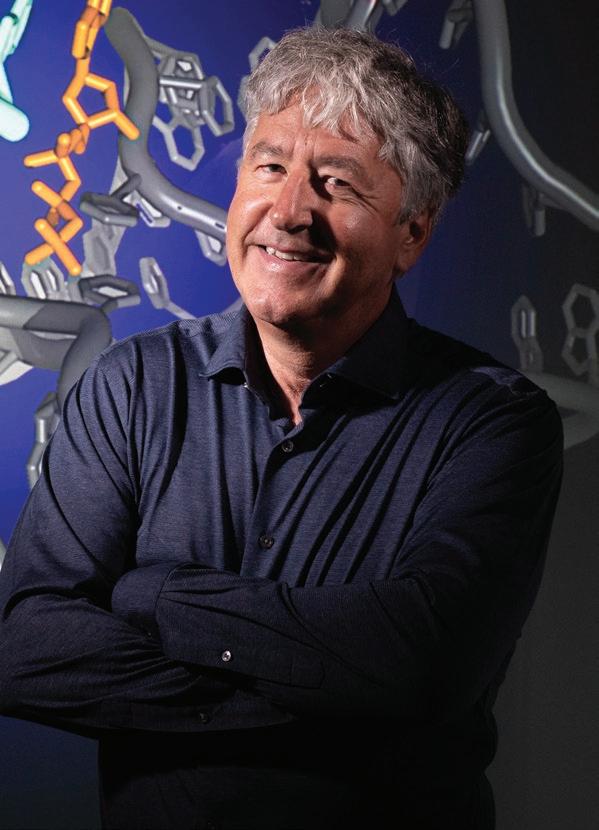
Joyce is considered a pioneer of in vitro (test-tube) evolution, a field that seeks to evolve molecules to adopt new functions, including those that would enable one to re-create the biomolecules of early life in the laboratory and to coax the building blocks of RNA to assemble, replicate, and evolve.
Among his many accomplishments, Joyce is known for engineering an RNA enzyme that makes a mirror-image copy of itself. The molecule, which he termed a “cross-chiral” enzyme, could be how the earliest self-copying molecules emerged on Earth. He also designed the first and several subsequent examples of DNA enzymes, some of which are now being tested in human clinical trials for the treatment of cancer, asthma, and skin diseases.
As Salk president, Joyce will lead the Institute’s scientific and philanthropic strategies, including the Campaign for Discovery,
a seven-year, $750 million comprehensive fundraising effort focused on accelerating discoveries in six critical research areas: cancer, healthy aging, plant biology, immunobiology, neuroscience, and computational biology.
“Salk’s prime objective has always been and always will be to produce high-impact science—that’s what the Institute is best at and that’s why I’m thrilled and honored to serve as president,” Joyce says. “I see this role as both a steward, overseeing this iconic campus that has been home to a long history of fundamental discoveries; and as a guide, leading the Institute’s continued evolution as science evolves. The investments we make in people and technology today will launch a thousand ships tomorrow. I can’t wait to see what we will achieve together.”
Joyce graduated with a BA from the University of Chicago in 1978 and both an MD and PhD from the University of California San Diego in 1984. He completed his postgraduate medical training at Mercy Hospital in San Diego and postdoctoral research training at the Salk Institute.
He is a member of the American Academy of Arts and Sciences, the National Academy of Medicine, and the National Academy of Sciences; a fellow of the American
Association for the Advancement of Science; and a foreign member of the Royal Swedish Academy of Sciences. He has received numerous awards and honors, including the 2005 International Society for the Study of the Origin of Life HC Urey Award, 2009 Göttingen Academy of Science’s Dannie Heineman Prize, 2010 US National Academy of Sciences Award for Early Earth and Life Sciences (Stanley Miller Medal), and 2016 Harvard Origins Prize.
Joyce succeeds Professor Rusty Gage, who served as Salk’s president for the past five years. Gage, a renowned neuroscientist, will return to leading his research laboratory full time.

“As I pass the baton, I have every confidence that our momentum will continue and build under the capable leadership of Jerry Joyce, whose multitude of professional accomplishments are only eclipsed by the magnitude of his personal character,” Gage says.

To learn more about Joyce’s personal and scientific journey, read the Q&A “Gerald Joyce: An Organizing Force” in the Winter 2022 issue of Inside Salk magazine.




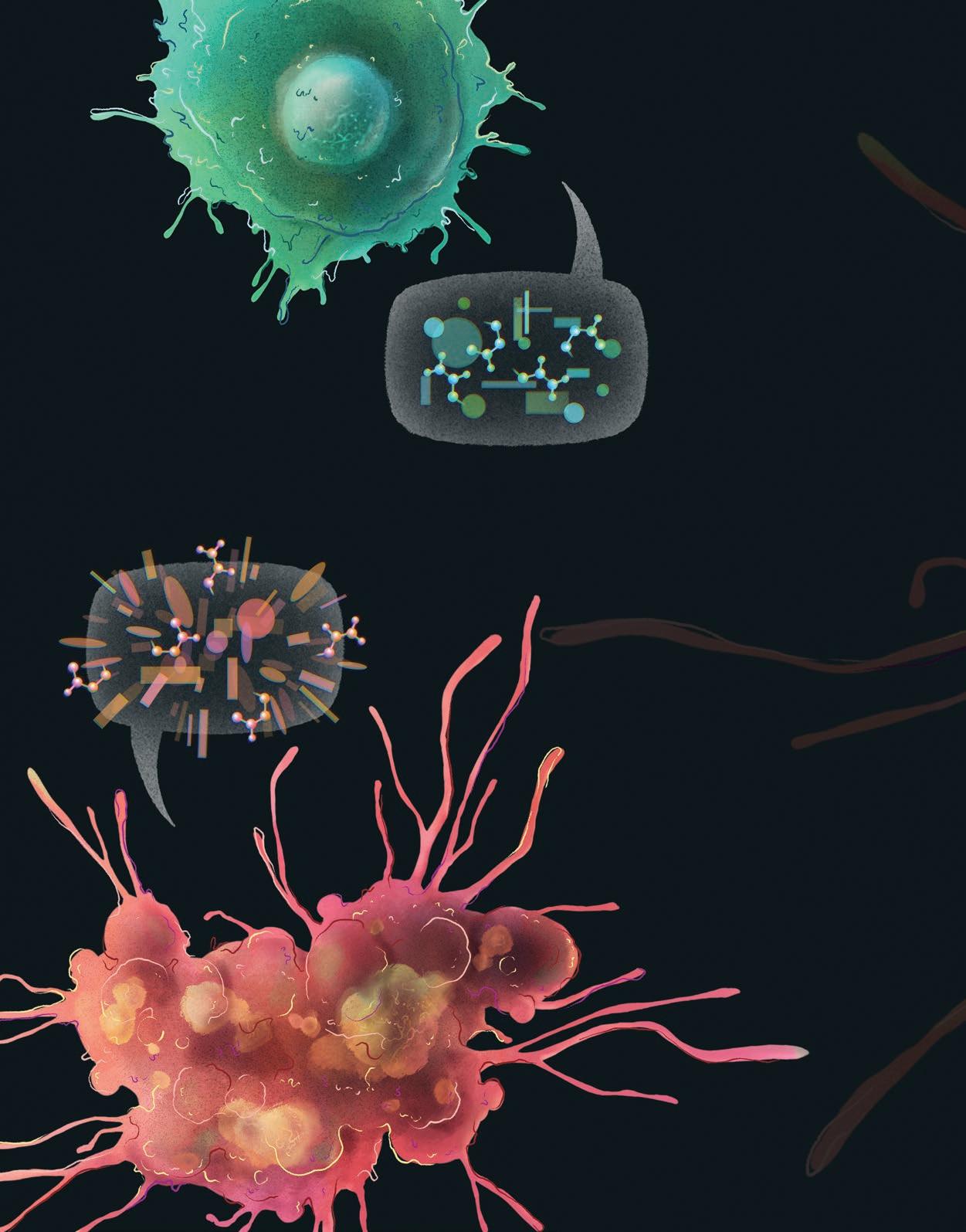

The conversations within and between our cells frequently turn to the topic of cancer. From the internal dialogue of a cell regulating its gene expression to bold cries in response to a cancerous neighbor—if our cells could speak, their tone, vocabulary, and volume would all change when cancerous cells are detected. At Salk, our scientists are working to decode this microscopic language of cancer. Their goal is to improve our understanding of cancer biology to fuel the development of more effective therapeutics.

Communication is key for warding off cancerous cells. As we age, the end caps of our chromosomes, called telomeres, gradually shorten.
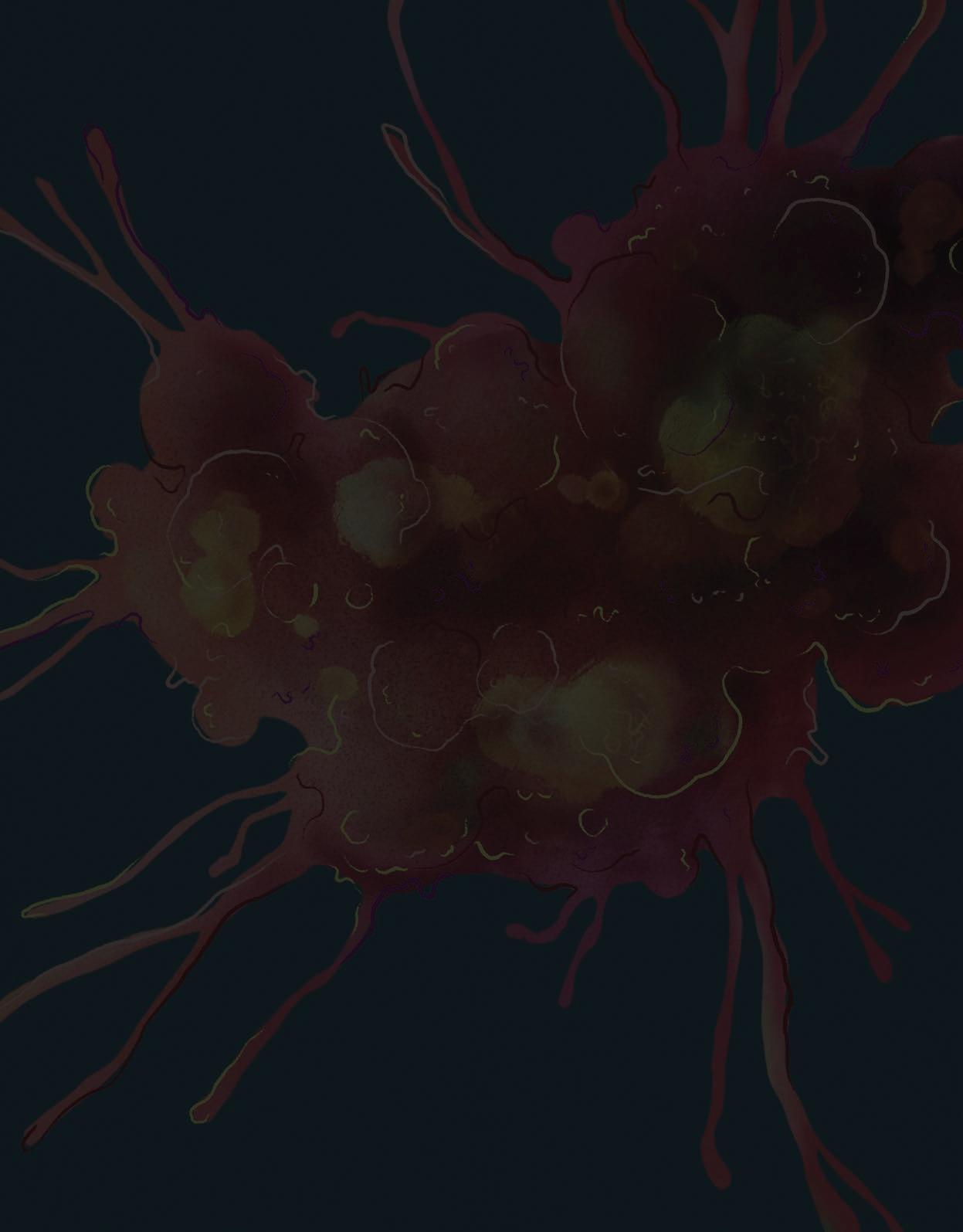
Professors Jan Karlseder and Gerald Shadel and colleagues have discovered that when telomeres become very short, they communicate with mitochondria, the cell’s powerhouses. This communication triggers a complex set of signaling pathways and initiates an inflammatory response that destroys cells that could otherwise become cancerous. These findings could lead to new ways of preventing and treating cancer, as well as designing better interventions to offset the harmful consequences of aging.
“Our findings, which show that stressed telomeres send an RNA message to mitochondria to cause inflammation, highlight the need to study interactions between these hallmarks to fully understand aging and perhaps intervene to increase health span in humans.”

PROFESSOR GERALD SHADEL
Salk scientists study how biological processes, like metabolism, can be used to improve cancer treatment outcomes. Tiny proteins, called microproteins, have long been overlooked in obesity and metabolic disease research. Now, Professor Alan Saghatelian and colleagues at UC Irvine have discovered that both brown and white fat are filled with thousands of previously unknown microproteins. They also showed that administering one of these microproteins, called Gm8773, can increase appetite in mice. Their findings may lead to the development of a therapeutic to help people gain weight in certain disease situations, such as during chemotherapy for cancer.
In addition to communicating with other cells, cells also have an internal monologue—one that occurs as they regulate gene activity. Assistant Professor Jesse Dixon, Postdoctoral Fellow Zhichao Xu, and colleagues have zeroed in on the specific mechanisms that activate oncogenes— altered genes that can cause normal cells to become cancerous. Cancer can be caused by genetic mutations, yet the impact of specific types, such as structural variants that break and rejoin DNA, can vary widely. The researchers found that genetic mutation activity depends on the distance between a particular gene and the sequences that regulate the gene, as well as on the activity level of the regulatory genetic sequences involved. The work advances the ability to predict and interpret which genetic mutations found in cancer genomes are causing the disease.


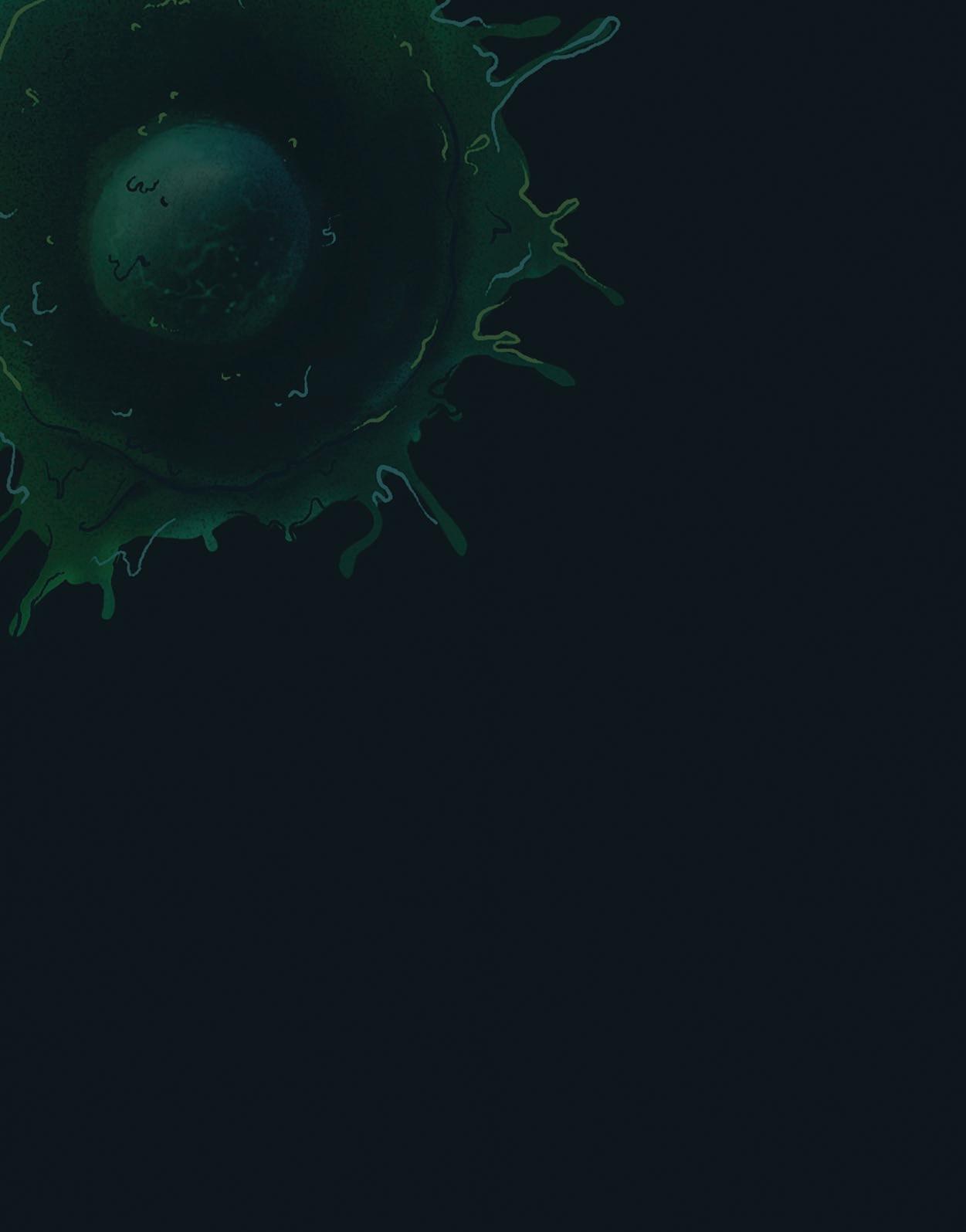
https://www.salk.edu/dixon202304

“It is vital to better understand the processes that regulate obesity and metabolic health in order to provide improved therapies for the future.”
PROFESSOR ALAN SAGHATELIAN
A drug developed by Salk Institute researchers acts like a master reset switch in the intestines. The compound, called FexD, was previously found to lower cholesterol, burn fat, and ward off colorectal cancer in mice. Now, cocorresponding authors Professor Ronald Evans and Senior Staff Scientist Michael Downes and colleagues have found that FexD can also prevent and reverse intestinal inflammation in mouse models of inflammatory bowel disease, an umbrella diagnosis that includes both Crohn’s disease and ulcerative colitis. Their research provides new, important information about the complex link between gut health and inflammation that has the potential to lead to an inflammatory bowel disease therapeutic.

Professor Satchin Panda and team, in collaboration with UC San Diego and the San Diego FireRescue Department, conducted a clinical trial and found that timerestricted eating improved measures of health and wellbeing in firefighters. Eating during a 10-hour window decreased firefighters’ “bad” cholesterol and alcohol intake, as well as improved their mental health, blood sugar, and blood pressure. The researchers also discovered that timerestricted eating may provide even greater benefits for those at risk for cardiometabolic disease and other chronic diseases.
https://www.salk.edu/panda202304

Approximately half of people with type 1 or type 2 diabetes experience peripheral neuropathy—weakness, numbness, and pain, primarily in the hands and feet. Now, working in mice, Professor Christian Metallo, Postdoctoral Fellow Michal Handzlik, and colleagues have identified another factor contributing to diabetes-associated peripheral neuropathy: altered amino acid metabolism. The researchers were able to alleviate neuropathy symptoms in diabetic mice by supplementing their diets with the amino acid serine. The findings may provide a new way to identify people at high risk for peripheral neuropathy, as well as a potential treatment option.
Credit: Courtesy of Cell Metabolism
 Salk researchers discovered the compound FexD can treat intestinal inflammation in mice. Mice with symptoms similar to inflammatory bowel disease had changes to the cells lining their intestines (left) that were reversed with treatment (right).
Journal cover image of Cell Metabolism illustrating a firefighter wearing a cape that represents eating within a time-restricted window.
Salk researchers discovered the compound FexD can treat intestinal inflammation in mice. Mice with symptoms similar to inflammatory bowel disease had changes to the cells lining their intestines (left) that were reversed with treatment (right).
Journal cover image of Cell Metabolism illustrating a firefighter wearing a cape that represents eating within a time-restricted window.


Despite decades of research, Alzheimer’s disease remains a debilitating and eventually fatal dementia with no effective treatment options. Now, Professor Rusty Gage, graduate student Joseph Herdy, and colleagues have found that neurons from people with Alzheimer’s disease show deterioration and undergo a late-life stress process, called senescence. These neurons have a loss of functional activity, impaired metabolism, and increased brain inflammation. Additionally, the team discovered that targeting these deteriorating neurons with therapeutics could be an effective strategy for preventing or treating Alzheimer’s disease.
When neurons involved in movement—called motor neurons—form, they must build connections that reach from the brain, brainstem, or spinal cord all the way to the toes. Now, Professor Samuel Pfaff, his team, and colleagues at the San Raffaele Scientific Institute in Italy provide a new understanding of how a “push-pull” relationship with blood vessels—in which growing neurons both attract blood vessels to them while also pushing them out of the way—guides the growth and development of motor neurons. Their discovery has implications for diseases in which motor neuron connections are destroyed, such as amyotrophic lateral sclerosis (ALS) or spinal muscular atrophy (SMA).

Aging involves complicated plot twists and a large cast of characters: inflammation, stress, metabolic changes, and many others. Professor Alan Saghatelian, Senior Research Associate Dan Tan, and colleagues, in collaboration with UC San Diego, revealed another factor implicated in the aging process—a class of lipids called SGDGs, which decline in the brain with age and may have anti-inflammatory effects. The finding could have implications for neurodegenerative disorders and other conditions that involve increased brain inflammation.


Growing motor neurons guided by “love-hate relationship” with blood vessels
Anti-inflammatory molecules that decline in the aging brain
NATURE NEUROSCIENCE
12/2022
As we move about in our daily lives, we tend to think that we navigate space in a linear way—but our brain does not always act in a linear manner. Professor Tatyana

Sharpee, graduate student Huanqiu Zhang, and colleagues discovered that time spent exploring an environment causes neural representations to grow in surprising ways. Neurons in the hippocampus, essential for spatial navigation, memory, and planning, represent space in a manner that conforms to a nonlinear hyperbolic geometry—a three-dimensional expanse that grows outward exponentially (like the interior of an expanding hourglass). This discovery provides valuable methods for analyzing data on neurocognitive disorders involving learning and memory, such as Alzheimer’s disease.
 New experiences are absorbed into neural representations over time, symbolized here by a hyperboloid hourglass.
New experiences are absorbed into neural representations over time, symbolized here by a hyperboloid hourglass.
“Our study demonstrates that the brain does not always act in a linear manner. Instead, neural networks function along an expanding curve, which can be analyzed and understood using hyperbolic geometry and information theory.”
PROFESSOR TATYANA SHARPEE

Numerous studies have shown health benefits from time-restricted eating, making practices like intermittent fasting a hot topic in the wellness industry. Now, Professor Satchin Panda and team show how time-restricted eating influences gene expression across more than 22 regions of the body and brain in mice. The team found a system-wide, molecular impact of time-restricted eating in mice, and noted that the time-restricted eating aligned the circadian rhythms of multiple organs in the body. The findings have implications for a wide range of health conditions, such as diabetes, heart disease, and cancer.

“Our results open the door for looking more closely at how this nutritional intervention activates genes involved in specific diseases, such as cancer.”
PROFESSOR SATCHIN PANDA
You can give any amount up to $100,000 per year from your IRA directly to the Salk Institute without paying income taxes on the revenue if you are 70 ½ years of age or older. You can also name Salk as a beneficiary of your retirement plan simply by filling out a form with your plan’s administrator. When left to Salk, retirement plan assets pass tax-free, allowing us to put 100 percent of your gift toward new discoveries in healthy aging, neurodegenerative disease prevention, climate change mitigation, and other major global challenges.

People who make a planned gift to Salk in their estate plans become members of our legacy society, Partners in Research, a visionary group that invests in the future of science.
We look forward to welcoming you as the newest member of our legacy society, Partners in Research.
To learn more, please contact the Office of External Relations at (858) 453-4100 x2277 or giving@salk.edu.
The power of a scientific legacy.

When Professor Reuben Shaw was in graduate school at MIT, a half-dozen years before he came to the Salk Institute, he was a groomsman in the wedding of his best friend from college. On the couple’s arrival in Hawaii from Massachusetts for their honeymoon, the bride complained to the groom of a pounding headache. It turned out to be glioblastoma, a deadly brain cancer. Three years later, Shaw was a pallbearer at her funeral.
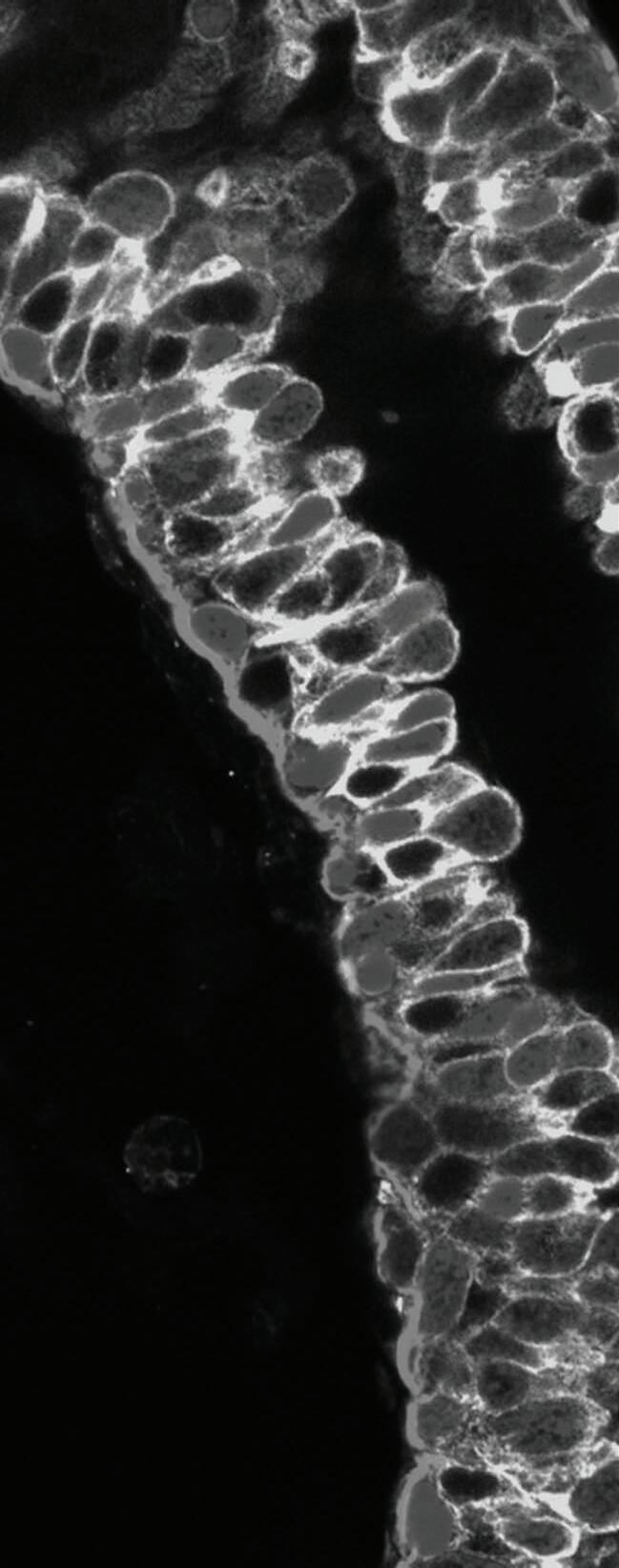
Even though Shaw was himself already a cancer researcher, this was his first personal experience with the devastating disease.
“It was just so cruel and disheartening because I already had dedicated my life to working on cancer. But the inability to change a thing couldn’t have been more stark than watching the experience of my dear friend and his lovely wife,” says Shaw.
Today, Shaw is working to change a lot of things about cancer as director of the National Cancer Institutedesignated Cancer Center at Salk, which turns 50 this year.

In that time, the Cancer Center has become a powerhouse of critical discoveries that have led to treatments and remissions for patients. Sixty percent of Salk’s faculty are members of the Center, and more than half of the Institute’s research focuses on cancer. But cancer is still the secondleading cause of death in the United States, after heart disease, and the Centers for Disease Control and Prevention projects that cancer rates will increase by almost 50 percent by 2050. So the Center’s mission, to make current generations the last to see cancer as anything other than a routine diagnosis, remains an urgent one.
Because scientific discoveries take time to be translated into therapies, there is no room for complacency—yet there is plenty of room for hope. Over the five decades since Salk’s Cancer Center was established, the scientific and medical community has traveled an almost unimaginable distance in its understanding of cancer. And Salk, as always, has been ahead of the curve.
Few words have the power to evoke such fear and dread as the word “cancer.” This disease of voracious cell growth has been with humans for all of recorded history, and likely much longer. For most of that time, little was understood about how it developed and effective treatments were nonexistent. But in the 20th century, that changed dramatically.
In the 1950s, scientists identified DNA as the hereditary blueprint of cells. It didn’t take many more years for them to connect DNA changes within cells to the development of cancerous tumors. One of the key figures for that discovery was Renato Dulbecco, an Italian physician-scientist who emigrated to the US after World War II to study viruses.


As a researcher at Caltech, he and fellow physician-scientist Marguerite Vogt discovered that some viruses can transfer their DNA into cells and cause them to become cancerous, a discovery for which Dulbecco would win a Nobel Prize in 1975. For the first time, scientists knew what caused cancer: rogue DNA. Researchers would soon begin discovering how cancer-causing DNA didn’t only come from outside of cells— via sources like viruses—but cells’ own DNA could undergo mutations that started them on the path to cancer. Dulbecco early on realized the importance—to health and disease—of cataloging every human gene, and was the first person to suggest a project to sequence the entire genome, an effort that became the Human Genome Project. That effort, completed in 2003, helped identify numerous cancer-causing genes.

1950s Dulbecco and Vogt discover the cause of cancer in the form of rogue DNA.
“It was exciting to work around the clock and to be part of experiments that solidified the idea that genes could be instrumental in provoking cancer. At the time, a lot of us didn’t quite appreciate the magnitude of what we were living. There was a lot to know and to discover.”
Dulbecco moved his lab to the Salk Institute in 1963—the year the Institute’s doors opened—accompanied by Vogt. With the arrival of cell biologist Walter Eckhart and biochemist Robert Holley a few years later, Salk would become a new hub of impactful cancer research.


Eckhart, who died in June 2022, began working as a postdoctoral fellow with Dulbecco in 1965, and in 1969 became one of the Institute’s first assistant professors. (See the tribute to Eckhart in the Winter 2022 issue of Inside Salk.) Eckhart studied the regulation of cell growth, including the effects of cancer-causing genes, known as oncogenes.
“It was exciting to work around the clock and to be part of experiments that solidified the idea that genes could be instrumental in provoking cancer,” Eckhart told Inside Salk in a 2012 memorial to Dulbecco. “At the time, a lot of us didn’t quite appreciate the magnitude of what we were living. There was a lot to know and to discover.”
Holley, a professor at Cornell University for most of his career, took a sabbatical at Salk in 1966-67 to study the

growth of mammalian cells. In 1968, Holley won a Nobel Prize for earlier work contributing to the understanding of how DNA guides protein synthesis. That same year, he was awarded a lifetime American Cancer Society Professorship, and moved his lab permanently to the Institute to focus on epithelial cells, which cover organs and line body cavities and where most human cancers originate.
Together, Dulbecco, Holley, and Eckhart began putting Salk on the cancer research map. Eckhart set up the Tumor Virology Laboratory and, with Dulbecco’s help, began recruiting exceptional faculty. In 1970, Holley established the Cancer Center at Salk and became its first director. The effort was designated a National Cancer Institute (NCI) Basic Laboratory Cancer Center in 1973, a prestigious accolade that, according to NCI, “recognizes centers around the country that meet rigorous standards for transdisciplinary, state-of-the-art research focused on developing new and better approaches to preventing, diagnosing, and treating cancer.”
Basic cancer centers focus on laboratory and preclinical research, although they collaborate with other entities that provide patient treatment. Salk’s Cancer Center was the second basic cancer center designated by NCI after the National Cancer Act of 1971 led to the creation of the NCI Cancer Centers program. Today it remains one of just seven basic cancer centers in the US, receiving significant grant funding every five years. NCI is the largest funder of cancer research in the world and, to Salk’s credit, the Institute has maintained its support continuously for 50 years.
PROFESSOR WALTER ECKHART, 2012
The Salk Institute receives special recognition as a National Cancer Institutedesignated Cancer Center, now one of only seven such centers in the US dedicated to basic cancer research.
Eckhart took over as Cancer Center director in 1975. In 2008, he was succeeded by Tony Hunter, whom Eckhart had hired as a postdoctoral researcher in 1971 and then recruited as an assistant professor in 1974.

“I have been a member of the Cancer Center since its inception in 1973, and it has been exciting to watch the Center’s growth and the great discovery science that has been done by its members over the past 50 years that is leading to new cancer treatments,” says Hunter, who is an American Cancer Society Professor as well as the Renato Dulbecco Chair.
Hunter is internationally renowned for his 1979 discovery of tyrosine phosphorylation, an on/off switch for genes that is responsible for telling cells to become cancerous. (Read more about Hunter’s discovery on page 24.)

Hunter’s discovery led to the development of a class of anticancer drugs called tyrosine kinase inhibitors, which have changed the prognosis of certain kinds of cancer from deadly to manageable. Former Salk Board Chair Daniel Lewis credits the kinase inhibitor Gleevec with giving him a new lease on life after his 2006 diagnosis of chronic myelogenous leukemia, a disease he says “was a three-year death sentence” historically.
“While we do very little translational medicine at the Salk, without the knowledge of how biological mechanisms work, there would be no translational medicine. There wouldn’t be ways to go from here to there,” Lewis told Inside Salk in 2018. “Gleevec is a perfect example.”
Lewis explained that Hunter wasn’t directly investigating human cancer when he made the discovery that ultimately led to tyrosine kinase inhibitors, but the discoveries that Hunter and others made in that area led to one of the most successful cancer drugs in the world. To uncover molecular mechanisms underlying cancer, “This is the great potential of doing the hard work that Salk, and other institutions like ours, do,” Lewis said.
Two other assistant professors recruited by Eckhart were Ronald Evans, in 1978, and Geoffrey Wahl, in 1980; both are full professors today.
Evans, now the March of Dimes Chair in Molecular and Developmental Biology, is known for discovering a large family of molecules called nuclear hormone receptors—chemical switches inside cells that regulate virtually every developmental and metabolic event in the body. They activate genes in response to various steroid hormones, vitamin A, and thyroid
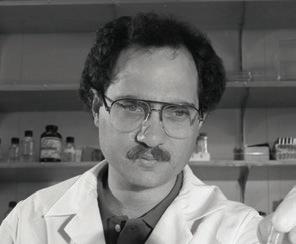
hormones. The receptors are also primary targets in the treatment of breast cancer, prostate cancer, leukemia, and pancreatic cancer.
More recently, Evans’ lab discovered that paricalcitol, a chemically modified form of vitamin D, might offer a new approach to the treatment of pancreatic cancer, an especially hard-to-treat cancer due to an immune shield that makes it difficult to attack the tumor.

“Though pancreatic cancer is a master of deception, by applying state-of-the-art science, we have ‘hacked’ the genomic code to reprogram the shield itself,” says Evans. “This completely changes the game.”
Evans co-leads a fully enrolled pancreatic cancer clinical trial at the Dana-Farber Cancer Institute. The clinical trial involves several of the five research strategies being deployed by Salk’s Conquering Cancer Initiative.
The Initiative, which was launched under Reuben Shaw’s guidance in 2018, is a scientific and philanthropic effort focused on unlocking foundational knowledge that will help
“Though pancreatic cancer is a master of deception, by applying state-of-the-art science, we have ‘hacked’ the genomic code to reprogram the shield itself. This completely changes the game.”PROFESSOR RONALD EVANS Ronald Evans Tony Hunter
in treating all cancers, with Salk researchers focusing on six of the hardest to treat: brain (glioblastoma), lung, triple-negative breast, pancreatic, ovarian, and colon. (See sidebar on page 23.)
One beneficiary of Evans’ experimental vitamin D treatment is Stephen Bigelsen, a physician who was diagnosed with stage IV pancreatic cancer in 2016. Stage IV is after the cancer has begun to metastasize, and the five-year survival rate is one percent. The average patient will live just one year after diagnosis.
“I’d like to thank my physicians and Dr. Ron Evans at the Salk Institute for saving my life,” Bigelsen said in a heartfelt 2019 video for a Conquering Cancer Initiative event at the Institute.
Professor Geoffrey Wahl is known for his studies of genomic instability in cancer, which led to his 1992 discovery identifying how a tumor suppressor protein, called p53, safeguards the cell’s genetic material. The p53 protein is mutated in more than half of all cancers. More recently, Wahl’s lab has been breaking down the complexity of pancreatic cancer, as well as discovering similarities between aggressive breast cancers and stem cells.
P53 turns out to play a key role here, too. Wahl’s collaborative studies with former Salk colleague Juan Carlos Izpisua Belmonte showed that p53 loss increases the chances of normal cells reverting to a developmentally unstable, stem-cell-like state, which Wahl’s lab found in aggressive basal-like human breast cancers. (Mature breast tissue contains two main cell types often involved in breast cancers—basal cells and luminal cells. Thus, immature breast cells can have “basallike” or “luminal-like” features.)
Making such discoveries involved creating a molecular map of normal breast development from breast tissue’s earliest stages to maturity, in order to better spot cellular alterations that may lead to tumor development later. His team identified a master switch that appears to control the dynamic behavior of tumor cells that make some aggressive cancers so difficult to treat. The gene Sox10, Wahl found, directly controls the growth and invasion of a significant fraction of hard-to-treat triple-negative breast cancers.

“Key ingredients in ‘Salk’s secret sauce’ are encouraging and giving the license to reinvent oneself,” says Wahl. “I did this multiple times during my 40-plus years at Salk, leading to new ways of understanding how cancer complexity arises, and ways to harness this knowledge to benefit cancer patients.”
Professor Geoffrey Wahl met Bianca Kennedy more than a decade ago. They both happened to be attending a cancer conference in Orlando when Kennedy shared her story of being diagnosed with breast cancer at the age of 35. When Wahl found out she lived in San Diego, he invited Kennedy for a tour of his lab, where he and his team study the links between cell development, cell repair, and cancer to understand how breast cancers initiate and progress to metastasis.
Soon after, Kennedy began regularly attending Wahl’s lab meetings—an opportunity for her to learn more about the science and for the researchers to better understand their mission to seek treatments for patients.
About a year after becoming embedded in Wahl’s team as a breast cancer research advocate, Kennedy was again diagnosed with cancer.
“As an advocate, I help put a face to the science,” says Kennedy. “Through conversations with the members of Dr. Wahl’s lab and showing them what I went through, they were able to see the impacts cancer had on me.”
Wahl’s team, accustomed to looking at cancer cells under a microscope, gained new perspective as Kennedy shared her journey through biopsies and surgeries. For example, one thing that stood out to them was her burn scars from radiation treatments. The experience motivated the researchers to find new, more humane and compassionate ways to fight tumors.
“The biggest recognition is that we are doing something positive for Bianca and others facing cancer,” Wahl says. “Bianca has an enormous impact on our lab and the researchers. She provides us with inspiration to move the science forward. It makes us appreciate the importance of finding the disease earlier, diagnosing with better accuracy, and understanding why recurrences happen.”
Kennedy says she never would have imagined that meeting someone at a conference could have had such an impact on her life.
“I feel so blessed to have met Dr. Wahl years ago and become a part of his lab. His wife, Dr. Barbara Parker, a respected local oncologist, became my doctor,” she says. “By sharing my story, I hope I contributed to advancing the science for other cancer patients. The relationships built will last a lifetime.”
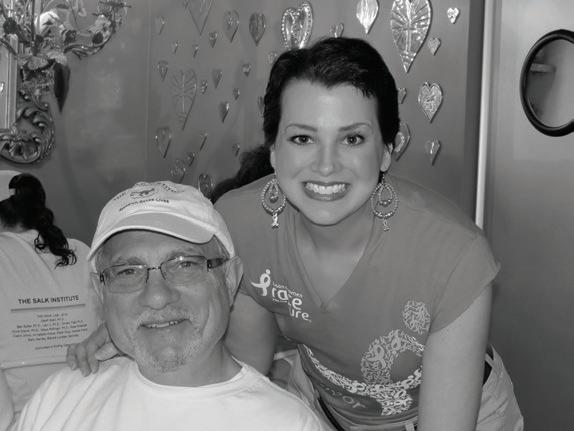
Hunter discovers tyrosine phosphorylation—an on/ off switch for genes that turns cells cancerous.
Reuben Shaw, the Cancer Center’s current director, took over from Tony Hunter in 2016. Hunter remains part of the Center’s leadership as senior advisor to the director.
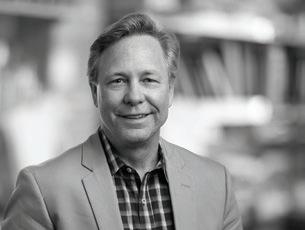

Shaw has been studying ways to target metabolic pathways that are altered in cancer for more than 20 years now, with a particular focus on lung and pancreatic cancers. (For more details, see Observations on page 30.) This work led to new approaches for attacking the fuel lines that cancer uses to grow, which is another of the Conquering Cancer Initiative’s five research strategies.
To conquer cancer requires therapeutic agents that are as genetically sophisticated and deadly as the cancer itself. There are few agents on the horizon more promising and exciting than oncolytic viruses, which seek, specifically

proliferate in, and then kill tumor cells, while activating a protective, long-lived anti-tumor immune response.
Professor Clodagh O’Shea, the Wicklow Chair and a Howard Hughes Medical Institute faculty scholar, is a trailblazer in the design of such therapeutic agents. Transformative synthetic biology and modular design technologies invented in the O’Shea lab have now enabled the systematic assembly of next-generation precision oncolytic viruses that overcome previous clinical barriers and limitations. This has also led to the development of a pipeline of new therapeutic agents—gene therapy vectors, vaccines, and oncolytic viruses—that have the potential to broadly disrupt the treatment not only of cancer but also a plethora of other intractable diseases. Technologies, seminal discoveries, and groundbreaking patents from the O’Shea lab over the past decade have been licensed and translated to biotech, including IOV-1042, which is scheduled to be tested in firstin-human trials for multiple different cancer indications and solid tumors in the coming year.
As the Cancer Center has grown, it has been able to delineate specific areas of research. In addition to Shaw, the current senior leadership includes four professorial deputy directors: Ronald Evans heads up Translation efforts; Geoffrey Wahl, Education and Training; Susan Kaech, Research; and Gerald Shadel, Shared Resources.
2016
Shaw becomes director of Salk’s Cancer Center.Gerald Shadel Reuben Shaw
In addition, staff member Leona Flores is executive director of Research Administration, and Shaw says the Cancer Center has benefited enormously from hiring Flores in March 2020. (Read more about Flores in Insights, on page 40.) Assistant Professor Dmitry Lyumkis rounds out the team, overseeing Diversity, Equity & Inclusion for the Cancer Center.

“The Cancer Center at Salk is smaller than many others, but it has an outsized impact,” says Kaech. “I think a big part of that success is how cross-disciplinary and collaborative our scientists are. In many cases, we look at problems differently.”


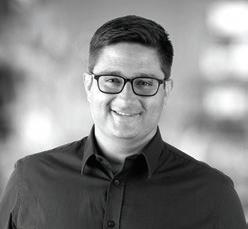
Kaech is known for discovering, among other things, that the way tumors partly cause immune suppression is by reducing the metabolism of immune cells called T cells, which are critical for maintaining long-term immunity to pathogens. Memory T cells also attack and fight cancer. Kaech seeks to decipher this process in order to create better therapies for cancer using the body’s own immune system—an innovative and rapidly moving field called cancer immunotherapy.

Along with the senior leadership, the Cancer Center also has faculty overseeing two programmatic branches that focus on different aspects of cancer research.
Program 1, led by Professor Jan Karlseder and Associate Professor Diana Hargreaves, focuses on genome stability (protecting cells’ DNA), epigenetics (turning genes on or off), and aging (one of the greatest risk factors for cancer).




Karlseder, the Donald and Darlene Shiley Chair, has exposed novel pathways during the earliest stages of cancer formation through his research on telomeres. Telomeres are the protective ends of chromosomes, which are constantly rebuilt in many cancers, thereby endowing cancerous cells with immortality. Much of his recent research has focused on how normal cellular processes, like materials recycling and natural (programmed) cell death, can go awry and lead to cancer. His work may yield potential interventions for stopping cancer in its developmental tracks.



Diana Hargreaves, the Richard Heyman and Anne Daigle Endowed Developmental Chair, studies epigenetic regulators—proteins that work to make specific regions of our genome more or less accessible for transcription (turning genes on and off) by cellular machinery. Mutations in these epigenetic regulator proteins are commonly found in tumors, indicating that controlling genome accessibility— and by extension, transcription—is an important safeguard to prevent cancer. Hargreaves’ lab has identified novel variants of a type of epigenetic regulator called the
 Diana Hargreaves
Geoffrey Wahl
Tony Hunter
Clodagh O’Shea
Ronald Evans
Christian Metallo
Susan Kaech
Diana Hargreaves
Geoffrey Wahl
Tony Hunter
Clodagh O’Shea
Ronald Evans
Christian Metallo
Susan Kaech
BAF complex, and their role in cancer, inflammation, and pluripotency (the ability of stem cells to become any cell type).

Program 2, led by Professors Christian Metallo and Janelle Ayres, is concerned with tumor immunology (using immune strategies to fight tumors), metabolism (attacking cancer’s energy sources), and therapeutics.
Metallo, the Daniel and Martina Lewis Chair, whom Shaw helped recruit to Salk from UC San Diego in 2021, was an already successful full professor in the field of cancer metabolomics. This field studies small molecules called metabolites, which result from the body breaking down substances, like food or drugs. At Salk, Metallo’s lab uses measurements of metabolic rates and other cutting-edge methods to trace how diet and therapeutics combine to selectively intercept specific subtypes of cancer. He and Shaw have been collaborating for years with Professor Alan Saghatelian, an expert in lipidomics, on new forms of cancer therapies. (Lipidomics is the study of naturally occurring molecules, such as fats.)
Ayres, the Salk Institute Legacy Chair, studies how our physiologies are regulated by microbes—tiny living things like bacteria and fungi. She seeks to understand how the mechanisms by which microbes promote our health represent a relatively unexplored aspect of host-microbe interactions, which provides an opportunity to discover new, dynamic biological processes in health and disease. Recently, Ayres and an international team of researchers were selected for a $25 million Cancer Grand Challenges award to study cancer cachexia, a debilitating wasting condition that often leads to a poor quality of life for people in the later stages of their cancer. It is responsible for up to 30 percent of cancer-related deaths.
Together, the Cancer Center leadership team and member faculty are changing our understanding of how cancer begins and how scientific breakthroughs can end it.
2023
Since Salk’s NCI-designated Cancer Center was established 50 years ago, Salk scientists have been continuously responsible for major advances in our understanding of how human cancer arises and attacks the body. Today’s Cancer Center faculty, from the most senior leadership to the newest assistant professors, are making discoveries that may one day result in new therapies or cures for cancer. (See the sidebar “Up-and-Coming Leaders.”)
Because it takes time for a body of research to be verified and translated into effective therapies, discoveries made 10-20 years ago may just be starting to yield fruit. After all, Hunter’s 1979 discovery about tyrosine phosphorylation didn’t result in tyrosine kinase inhibitor drugs until the early 2000s. Now 20 years on, more than 60 tyrosine kinase inhibitors have been approved for clinical use, with more on the horizon. The time to invest in future cancer therapies is now. Public and private support will ensure that the Cancer Center’s next 50 years will be just as impactful as the first 50, if not more so.
“In the Cancer Center at Salk, we can’t stop bringing the fight to cancer. It’s relentless, and so must we be,” says Shaw. “We’ll continue to push to develop new therapeutics, to identify targets, and to work collaboratively across disciplines—a Salk hallmark—to come up with truly unexpected breakthroughs that lead to future medicines.”
The Cancer Center at Salk Celebrates 50 Years of Life-Changing Discoveries.
A centerpiece of Salk’s Campaign for Discovery is the plan to build the Joan and Irwin Jacobs Science and Technology Center. The building will house the Cancer Center together with the Center for Plant Biology, Crick-Jacobs Center for Theoretical and Computational Biology, and Center for Healthy Aging—magnifying opportunities for collaboration and furthering interdisciplinary research.
Jesse Dixon uses molecular and computational biology to explore how abnormal genome folding leads to errors in critical stretches of noncoding DNA that cause many diseases, such as cancer. He recently discovered that whether specific gene mutations cause cancer depends on the distance between a particular gene and the sequences that regulate the gene, as well as on the level of activity of the regulatory sequences involved. This work could help predict and interpret which genetic mutations found in cancer genomes are causing the disease.

Dannielle Engle, who has lost close family members to cancer, uses her personal and scientific passion, as well as her expertise in modeling, to facilitate progress in pancreatic cancer research by creating better representations of what actually happens in patients. In 2021, she was awarded the Lustgarten Foundation-AACR Career Development Award for Pancreatic Cancer Research in Honor of Ruth Bader Ginsburg. Engle is also part of a partnership between the Salk Institute and the Lustgarten Foundation focused on identifying and validating potential targets for new pancreatic cancer drugs. The $5 million effort also includes Professors Evans, Hunter, and Shaw.
Christina Towers uses a variety of techniques to uncover how cancer cells recycle both their own nutrients and the power-generating structures called mitochondria in order to survive. Her goal is to develop new targeted cancer therapies that can block the recycling pathways that allow these cells to survive. She has received several young investigator awards, including the Chan Zuckerberg Initiative’s Diversity Leadership Award and the Black in Cancer Young Investigator award, along with being named a Pew-Stewart Scholar for Cancer Research. These awards, totaling more than $1.6 million, will help Towers study the recycling process (called autophagy) and how cancer cells adapt when this pathway is blocked. (Read more about her lab’s work in Next Gen on page 42.)
Graham McVicker studies how human genetic variation affects gene regulation by combining experimental approaches with computational analyses. McVicker, the Frederick B. Rentschler Developmental Chair, is especially interested in identifying pathogenic regulatory variants that act in immune cells and cancer cells. In October 2022, he was one of 12 scientists (along with Professors Hunter and Shaw) to be named inaugural Discovery Grant winners by Curebound, a philanthropic organization dedicated to funding collaborative cancer research that has the potential to reach the clinic.

Daniel Hollern merges two disciplines, computational medicine and cancer immunology, to find where tumors are vulnerable and how they can be controlled therapeutically by the immune system. In particular, his lab focuses on triple-negative breast cancer, where management of advanced disease is very challenging and for which he was recently awarded a Career Catalyst Research grant from the prestigious Susan G. Komen Foundation.

• Leslie Orgel discovered a simplified and economical way to make Ara-C, a drug that prevents cancer cells from copying their DNA and dividing.

• Rudolph Janeisch created the first transgenic mouse, whose genome contained DNA from the SV40 tumor virus.
• Inder Verma pioneered stripped-down viruses to destroy cancerous cells and enhance healthy cells’ ability to fight cancer.

• Cut Cancer’s Fuel Supply – hit the metabolic Achilles’ heel
• Fight Fire with Fire – reduce inflammation to lower cancer risk
• Decode Cancer Genomes – discover the key genes to therapeutically target in each patient
• Mobilize the Immune System – turn suppressed immune responses into effective responses
• Re-engineer Therapeutics – use computational and systems approaches to identify optimal therapy combinations
To learn more, visit www.salk.edu/conquering-cancer-initiative


In 1979, Professor Tony Hunter had only recently started his lab at Salk when he saw something no one else had even thought to look for before—a cellular switch called tyrosine phosphorylation. Today, more than 60 cancer drugs work because they inhibit that switch.
To survive and replicate, viruses hijack their host’s cell machinery, turning them into mini virus-making factories. It’s in a virus’ best interest to force its host into making more cells. But it’s bad news for the host when those cells start dividing out of control, and eventually become tumors.
In the 1970s, excitement was growing about tumor viruses—viruses that cause cancer in animals. Hunter, then a junior faculty member at Salk, Karen Beemon, a member of his lab, and Bart Sefton, another junior faculty member, were studying two such viruses: polyomavirus and Rous sarcoma virus, which cause cancer in mice and chickens, respectively.

“Because these viruses are so simple—one has just four genes and the other has six—we hoped we could figure something out about how one or a few genes are able to convert normal cells into cancer,” says Hunter, who, turning 80 this year, is now Salk’s most senior faculty member, American Cancer Society Professor, and holder of the Renato Dulbecco Chair.
Not only would that information help them understand virally induced tumors in animals, Hunter thought, but it might also illuminate the ways human cells become cancerous.
A breakthrough came when a research group in Denver discovered that one Rous sarcoma virus gene encodes a kinase, and that it’s responsible for the virus’ ability to trigger tumors. Kinases are enzymes that add phosphate groups—chemical tags—to other proteins, altering their structure and function.
Phosphorylation by kinases is a common way cells make changes on the fly to meet the body’s everchanging needs. And it’s easy to reverse the change, with phosphate-removing enzymes.

But the idea that a virus could use a kinase to remove the brake that keeps cells from constantly dividing was new and
fascinating. Scientists around the world got to work, testing their favorite cancer-causing viral proteins to see if they had kinase activity.

Hunter’s team made the exciting discovery that a polyomavirus protein, known as Py middle T, has kinase activity that was needed for the virus to convert normal cells into cancer cells. This gave Hunter the idea that there might be a general process in which these viral kinases phosphorylate cell proteins and force host cells to replicate themselves even when they shouldn’t.

But two big questions remained: Which proteins were being phosphorylated by the Py middle T kinase? And what parts of those target proteins were being phosphorylated? At the time, the only known places that kinases tagged proteins with phosphate groups were on the amino acids threonine and serine. (There are 20 different types of amino acids, and all proteins are made up of some combination of them.)

Tony Hunter’s key June 1979 experiment: This is the X-ray film taken of a cellulose thin layer electrophoresis plate in which Hunter separated the amino acids that make up Py middle T protein. He saw an unexplained radiolabeled spot (which he initially labeled “X”) between two well known phosphorylated amino acids, serine and threonine. That mystery spot turned out to be the first evidence of phosphorylated tyrosine.


In June 1979, Hunter ran an experiment with Py middle T protein, which itself is phosphorylated by the viral kinase, expecting to find that it was phosphorylated at threonine or serine.
Using a technique called cellulose thin layer electrophoresis, Hunter first took a sample of phosphorylated Py middle T protein in which the phosphates were labeled with a radioactive marker for easy detection. He used a strong acid to break the protein up into individual amino acids, loaded the amino acids onto the plate, wet it with pH 1.9 buffer, and ran an electric current through it.
The phosphorylated amino acids migrated toward the positive end of the plate. Phosphorylated amino acids with the greatest negative charge-to-mass ratio move further through the plate’s cellulose pores, meaning phosphorylated serine moves further than phosphorylated threonine, which is bigger.
Hunter then dried the plate and laid an X-ray film on it. After developing it the next day, he ended up with a film with dark spots indicating where the radio-labeled, phosphorylated amino acids had run on the plate.
At that point in time, scientists knew where phosphorylated threonine and serine would run on these plates, based on their size and charge. Because Hunter had added unlabeled phosphorylated serine and phosphorylated threonine to the sample run on his plate, he saw where those should be on his film, but they were not labeled with radioactive phosphate.
Instead, he saw an unexplained radio-labeled spot between phosphorylated serine and phosphorylated threonine, which he initially labeled “X.” (See image above.)
As a biochemist, Hunter knew that, at least theoretically, another amino acid called tyrosine could also accept a phosphate group. But if this mystery spot was indeed phosphorylated tyrosine, why would it suddenly appear here, when no one had ever seen it before? This possibility intrigued Hunter, who made up some phosphorylated tyrosine to test if it was “X.” It was.
“The protocol had called for the separation buffer to be pH 1.9. But I kept reusing the old stuff instead of making it up fresh, and unbeknownst to me the pH had dropped to 1.7,” Hunter says.

The small pH drop was responsible for the separation of phosphorylated tyrosine from threonine, which normally move together at pH 1.9 and appear as one spot on a plate.
And that is how Hunter discovered the first kinase that phosphorylates the amino acid tyrosine.

Before Gleevec, only 22 percent of people with chronic myelogenous leukemia (CML) survived five years past diagnosis. Today, more than 70 percent of patients diagnosed with CML survive, and 90 percent of CML patients are still alive after five years.
Hunter and team published their revelation in the journal Cell in December 1979, followed by another landmark paper in Proceedings of the National Academy of Sciences in March 1980, where they showed that the Rous sarcoma virus’ cancer-causing kinase was also phosphorylating proteins at tyrosine.
“I spoke about our work at a phosphorylation meeting in Switzerland in December 1979. And then the world just exploded,” Hunter says. “Everyone who heard about tyrosine kinases wanted to get the phosphorylated tyrosine marker we had used to detect it.”



He went on to publish many additional papers about other tyrosine kinases, in viruses and humans, over the following decades. Human tyrosine kinases, it turns out, normally play important roles in embryonic development and cell proliferation. But they also become overactive in many cancers, where they help drive tumor development.
Understanding what drives tumor growth gives scientists a potential way to stop it. Drugs that treat cancer by inhibiting tyrosine kinases began emerging in the early 2000s, and since then more than 60 have been approved for clinical use.

The most famous tyrosine kinase inhibitor, imatinib (brand name Gleevec), is now routinely used to treat chronic myelogenous leukemia (CML). Before Gleevec, the only treatment options available to patients with CML were bone marrow transplantation and daily infusions of interferon, a molecule that helps a patient’s immune system to fight their cancer. Both had serious side effects. And even with those therapies, in the 1970s only 22 percent of people with CML survived five years past diagnosis.
Now, more than 70 percent of patients diagnosed with CML survive. One large study found that 90 percent of CML patients treated with Gleevec were still alive five years later.
“A gratifying outcome of this set of experiments on a simple chicken tumor virus,” Hunter modestly wrote in a 2015 Proceedings of the National Academy of Sciences perspective recounting his discovery.

June 2019 marked the 40th anniversary of Hunter’s discovery of the first tyrosine kinase. A small group of colleagues gathered in a Salk conference room that month to celebrate it. But the milestone wasn’t truly noted until June 2022, at the 21st Post-Translational Regulation of Cell Signaling meeting—a conference of kinase experts co-organized by Hunter and held at Salk. Many of the speakers at the recent gathering were involved in the field from the very beginning, including Harold Varmus, who won the 1989 Nobel Prize for his seminal work on tumor viruses.
Over the years, Hunter has co-organized more than 30 scientific meetings at Salk on different topics, including previous milestone celebrations of tyrosine phosphorylation’s discovery in 1990, 2000, and 2010.
“I felt it was important to bring great science and scientific meetings to the San Diego area, which wasn’t something that was happening regularly in the 1980s or ‘90s,” Hunter says. “Most meetings were being held only on the East Coast.”

Now well into his sixth decade at Salk, Hunter is at the front lines of what he calls “a new area of phosphorylation.” It’s emerging that some kinases also phosphorylate histidine, another of our 20 amino acids, and that this phosphate label may play roles in human health and disease much like phosphorylated tyrosine. Hunter’s lab generated the first antibodies recognizing phosphorylated histidine. Now they are engineering better antibodies that bind with higher affinity and are using them to probe cells to unravel phosphorylated histidine’s function in normal cells and cancer.
“When I’m teaching students, I say an awful lot has already been discovered, but an awful lot remains unknown. I’m sure that new biological principles will emerge that we can’t even imagine right now,” Hunter says.
“I’m excited because there will always be new things to be discovered for as long as I’m alive.”
“When I’m teaching students, I say an awful lot has already been discovered, but an awful lot remains unknown. I’m sure that new biological principles will emerge that we can’t even imagine right now. I’m excited because there will always be new things to be discovered for as long as I’m alive.”
PROFESSOR TONY HUNTER





It’s not every day a young scientist gets a jaw-dropping result he knows no one will believe. But that’s exactly what happened to Professor Reuben Shaw 20 years ago, in the spring of 2003.
 Inside Salk sat down with Shaw to learn about his scientific journey and vision for Salk’s Cancer Center.
Inside Salk sat down with Shaw to learn about his scientific journey and vision for Salk’s Cancer Center.
Shaw was a postdoctoral researcher at Harvard Medical School studying a tumorsuppressing gene called LKB1, which encodes an enzyme by the same name. When mutated and no longer functioning as a tumor suppressor, LKB1 can cause several types of inherited cancers. In fact, LKB1 is the thirdmost frequently mutated gene in human lung cancer, meaning tens of thousands of new patients are diagnosed with lung cancer containing mutated LKB1 every year. Unfortunately, the prognosis for those patients is worse than for lung cancer patients with any other mutated cancer gene.
That day back in 2003, after years of studies to understand how LKB1 worked to block tumor growth, Shaw’s experiment showed that LKB1 was switching on another enzyme, called AMPK. At first, Shaw couldn’t believe his eyes. AMPK was known for being a central metabolism gene linked to diabetes. It seemed too wild to be believable—could an anticancer gene really work by activating an anti-diabetes gene?
Shaw’s finding was so unexpected, he thought the scientific community wouldn’t believe it. And initially, many didn’t. But Shaw was right. AMPK is a fuel gauge that senses when a cell’s fuel is low—like when we fast or exercise—and changes the cell’s metabolism in response. In the case of cancer, AMPK prevents developing tumors from getting fuel to grow. So, Shaw’s metabolic connection between cancer and diabetes via LKB1 and AMPK made sense in the end. This discovery also helped explain how the widely prescribed diabetes drug Metformin works (it also turns AMPK on), as well as pointing to a new way to tackle cancer: by cutting its fuel supplies.
That discovery led to a job offer from the Salk Institute, and today Shaw is a professor and director of its National Cancer Institute (NCI)-designated Cancer Center. Inside Salk sat down with Shaw to find out more about his scientific journey.
RS: I grew up on a dairy farm in rural upstate New York, on around 50 acres in the Taconic Mountains, which are known as the Berkshires when they cross into Massachusetts. We basically owned this little hill, so I grew up exploring the woods and the creeks and everything around the house. Then, when I went off to college at Cornell University, I just gravitated toward biology.
You’ve said that your undergraduate years were an exciting time to be in biology—why was that?
RS: When I was taking freshman biology, the ability to identify disease genes had just happened in the previous handful of years, in the mid-’80s. The Huntington’s disease gene. The cystic fibrosis gene. Early-onset breast cancer genes. Doctors had been treating these diseases with whatever crude methods could relieve some of the

symptoms, but until the 1980s, the actual root causes of these and so many other diseases were literally unknown. That meant, for the first time, treatments could be far more strategic and targeted—actually scientific—versus whatever random thing had been found up to that point to do anything to help. As a young college student, it was just mind-blowing to me to connect genes to diseases so clearly.
What made you come to Salk when you had lived your whole life in the Northeast and had offers from major schools and cancer centers in Boston and New York?
At first it seemed crazy to leave the only environment I had ever known and had done so well in—the Northeast. But there was something very different about Salk than the other places I had job offers from. All of them were strong in cancer research, but the difference was that, despite being small, Salk also had the world’s luminaries in metabolism, physiology, and neuroscience. Salk had Professor Tony Hunter [a cancer expert], but it also had Professor Ronald Evans [a metabolism expert]. And they were both down-toearth despite being brilliant and acclaimed scientists! All in this one small, amazing building with no departments and no walls between labs—and with a clear track record of labs working across fields, resulting in unexpected findings decade after decade. That idea and the potential to work in such a concentrated “think tank” of experts across fields, from plants to neuroscience to metabolism to cancer, was just unique.
Did you find that to be true? Did the track record of working across fields influence your lab’s research when you got here?
RS: Yes and yes. While doing cancer research using cuttingedge genetic mouse models and testing new therapies based on changes in tumor metabolism in those models—which my lab might have done anywhere I went—we also pursued crossdisciplinary collaborations that would not have happened anywhere else. In work with Professor Marc Montminy, we examined how these same biochemical circuits control diabetes, and how they extend life span in some species; with Evans we studied how these circuits govern the response to exercise—and that was all in the first 10 years I was here. Since then we have made connections to neuroscience that relate to Professor Rusty Gage’s research, and are even working with Professor Wolfgang Busch on how this same pathway impacts root development in plants when they are deprived of nutrients. We’re working with Professors Christian Metallo and Alan Saghatelian on whether drugs originally made for diabetes may someday find great use not only in cancer, but also in a wide variety of other diseases.
Often, being an outsider to a field is what enables big discoveries.
What are some of the projects you are most excited about in the lab now?
RS: We have had good fortune in discovering and pursuing new potential therapies that target metabolic changes in specific genetic subsets of cancer, but this has been painstaking work. It takes five years just to test one possibility
of one node in one subtype of cancer. Over the last decade, I have helped recruit a “dream team” of the next generation of professors who are experts in different facets of metabolism in normal and diseased cells and tissues, as well as the immune system. Collectively, this broad set of relatively new Salk faculty are collaborating and really making larger strides to unbiasedly decode all metabolic vulnerabilities within major classes of cancer and the surrounding microenvironment, including immune cells. In the meantime, we have also made major strides in the basic understanding of how different cellular biochemical pathways communicate with each other in response to changes in nutrients and diet and how the body adapts.

New technologies and new insights have made this an exciting time to be studying metabolism and therapies in a wide variety of diseases, including cancer.
This is the 50th anniversary of the Cancer Center at Salk. As director, what are your thoughts about that?

RS: Salk has been laser-focused on cancer discoveries and cancer therapies for 50 years, and there are only a handful of organizations in the US that are part of that legacy. It’s remarkable. Discoveries made at Salk have led to successful cancer treatments that have literally changed people’s lives. And our [National Cancer Institute] designation—the fact that we were already organized as cancer researchers under Salk Professor and Nobel Laureate Bob Holley is what led us to be one of the first places in the country to get the NCI designation, which is really something to be proud of. Holley and Salk Professor Renato Dulbecco, another Nobel laureate, put Salk on the map for cancer, and Professor Emeritus Walter Eckhart and Hunter—along with another wave of faculty they hired— continued the legacy, keeping Salk’s Cancer Center at the forefront of cancer research in the US for 50 years. That does not happen easily and it is not maintained easily.
But as much as we’ve accomplished already, I think the future is going to be even brighter because Salk has built up so much momentum in cancer research. We have incredible researchers supported by phenomenal donors. And we never forget who we’re really working for—cancer patients and their loved ones, who are counting on us for breakthroughs.
RS: What keeps scientists motivated is the unknown— discovering things that are completely unknown and continuing to overturn new rocks to see what’s there. And, then, having the intellectual freedom to pursue different aspects of the discoveries. That’s why I came to Salk. We do not have research “silos,” so some of the discoveries may lead to new cancer therapies and others may lead to new Parkinson’s therapies.
As I get older and more established in my career, it is more and more impactful to me to help enhance and promote the careers of the next generation of researchers. At the end of the day, the world of science is small—I am still connected to people I trained with in Boston, the people who I have collaborated with over the past 20 years, and the students and postdoctoral researchers who have worked with me, several of whom have themselves become professors or leaders in biotech companies developing future medicines. We all form a human web of people doing biomedical research across the country, moving the ball down the field to make new research discoveries and design the therapies of the future. In my lifetime, I really hope to see major forms of cancer put into steady remission, and in my children’s lifetime, to have cancer turned into an ailment that gets treated and monitored, but one in which survivors then return to an otherwise unencumbered life. It’s good to have goals.
For more details, listen to Shaw’s interview on episode 14 of the Salk podcast at salk.edu/podcast.
“Discoveries made at Salk have led to successful cancer treatments that have literally changed people’s lives. But as much as we’ve accomplished already, I think the future is going to be even brighter because Salk has built up so much momentum in cancer research.”
PROFESSOR REUBEN SHAW


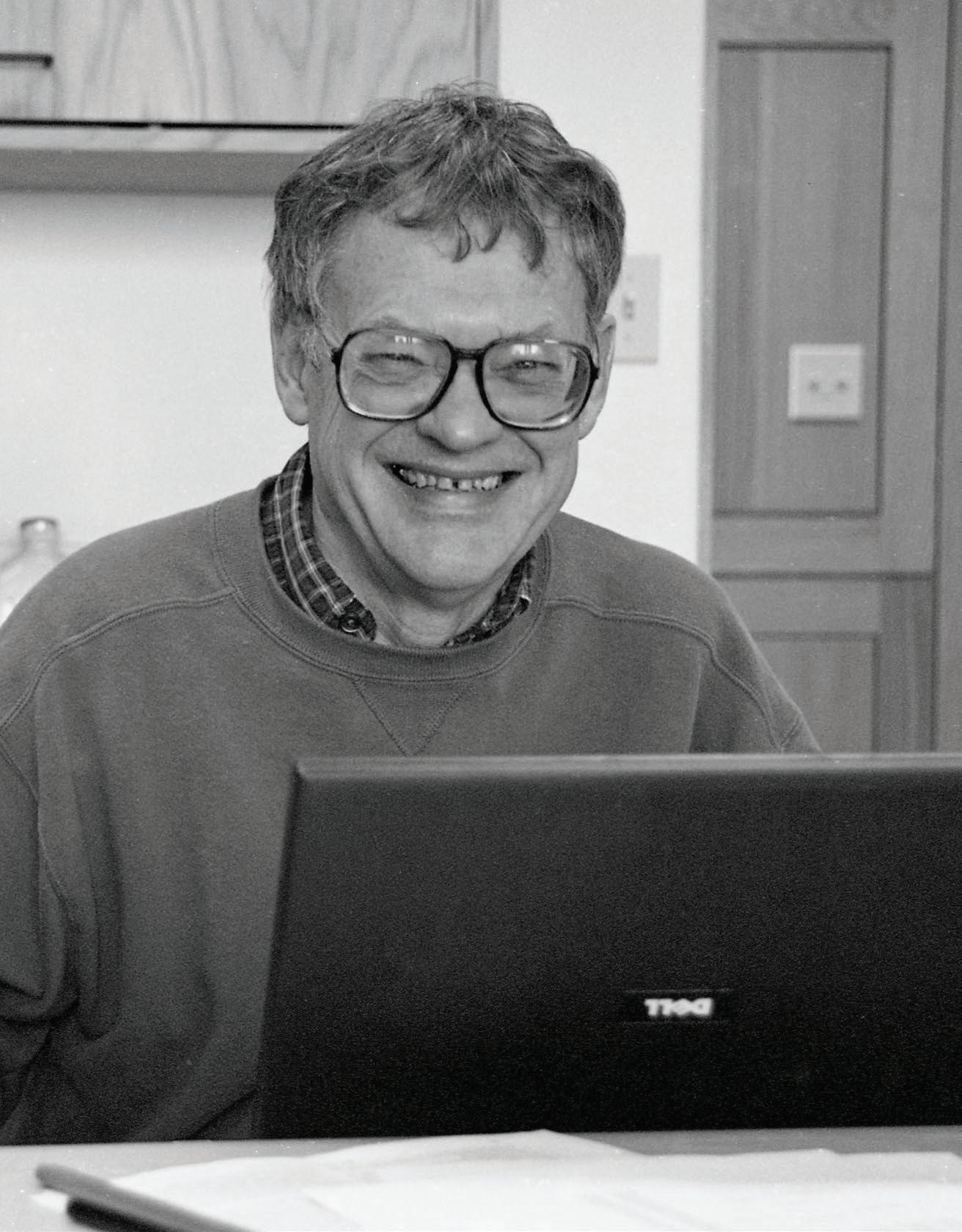
Considered a pioneer in

Charles F. Stevens died peacefully on October 21, 2022, at his home in San Diego. He was 88.
Stevens joined Salk in 1990, after serving as a faculty member at the University of Washington School of Medicine and Yale School of Medicine. He was also a research scientist and advisory board member with the Kavli Institute for Brain and Mind at UC San Diego. He remained on Salk’s faculty until 2018.

“Chuck was a giant in modern neuroscience,” says Salk President Rusty Gage. “He pioneered many techniques to study how messages are transmitted across synapses in the brain and how these signals help us learn and remember. He always brought unique perspectives to any problem and inspired us all to think more creatively. But what’s more, he always had time to talk with his colleagues and trainees, many of whom went on to become accomplished neuroscientists themselves. He will be missed.”
Stevens was responsible for confirming via modern experimentation long-held beliefs regarding the consistency of neuron density throughout the brain. He was also a leader in exploring and understanding the scalable architecture of the brain, which centers on the idea that something can gain more properties simply by becoming bigger.
Stevens worked to formulate a complete list of the principles that govern organization in the brains of a wide variety of animals, from simple creatures to humans. He sought to know how scalable architecture is enforced in the brain and if there are always constant ratios between the sizes of cells and structures.
To answer these fundamental questions, Stevens pinpointed the scaling laws that govern how brains grow and develop. He observed how organisms develop from an embryo to an adult using goldfish as a model organism. Unlike mammals, goldfish have brains that continue to grow throughout their adult lives. Stevens unearthed several design rules of the goldfish brain, such as set relationships between certain brain areas and laws on how neurons leading from the eyes to the brain are organized. He charted how those rules are enforced during development and growth.
Stevens was born on September 1, 1934, in Chicago, Illinois, to Russell Stevens and Reba Hoffman Stevens.
He married Jane Robinson on June 18, 1956, shortly after he graduated from Harvard College and she graduated from Wellesley College. He was the first person in his family to receive a bachelor’s degree.
After earning his Bachelor of Arts degree in psychology from Harvard, Stevens received an MD from Yale University and a PhD in biophysics from the Rockefeller Institute. He was elected to membership in the National Academy of Sciences in 1982 and the American Academy of Arts and Sciences in 1984. He was formerly a Howard Hughes Medical Institute investigator and adjunct faculty member in the UC San Diego School of Medicine department of pharmacology. He was awarded the National Academy of Sciences’ Award for Scientific Reviewing in 2000.
Stevens is survived by his wife, Jane R. Stevens; their daughters Katharine B. Stevens of Washington, DC, and Alexandra Stevens Thomas of Madison, Wisconsin; and three grandchildren. He was preceded in death by a daughter, Margaret R. Stevens O’Neill.
In memory of Stevens, his family welcomes donations to the Charles F. Stevens Neuroscience Research Fund at UC San Diego, which was established to provide research grants to graduate students working in the field of neuroscience. Go to giveto.ucsd.edu and search “Charles F. Stevens.”

“Chuck was a true polymath, imbued with a beautiful mind and a heart to match. As a colleague one could but hold him in awe. While his interests were broad, he was first and foremost a scientist, and a generous one at that. On any given day you would find him in the lab or his office doing what he loved most, with his wife, Jane, joining him on the weekend where she, too, would beaver away on her classical music studies. His research, which combined theory and experiment with math and neurophysiology, is the thing of textbooks. What more can a scientist want but to see your foundational findings stand the test of time and the people you trained make important discoveries, too.”
Professor Martyn Goulding
“When I arrived at the Institute in 1978, Salk was at the epicenter of the new molecular era of neuroscience. A powerhouse, with Roger Guillemin, Wylie Vale, Steve Heineman, and soon Max Cowan. However, with a background in math and theoretical physics, Chuck Stevens pioneered a new approach to understanding ‘things’ like learning and memory. Chuck was a unicorn, loved to chat, loved to think, loved to push boundaries, and simply loved to think about thinking. He often sat alone in silence (presumably deep in thought), eating lunch on the travertine bench in the Salk courtyard. At the same time, if I caught his eye, he’d be more than happy to chat and always loved a good joke. He was a transformative figure, a type of pure scientist who challenged everyone to think differently.”
Professor Ronald Evans“I met Chuck at the very first scientific meeting that I ever attended. It was in the early winter of 1980 at Cold Spring Harbor. He has been an inspiration to me since that time: smarter than most, open to any and all new ideas from anyone, anywhere, and always driven to understand the workings of the world. Chuck was very special and very important. I will miss him.”
Professor Greg Lemke“Chuck was a deep and highly original thinker, who—even after he closed his lab—continued to publish theoretical papers on a wide range of neurobiology topics, such as brain architecture. One wonderful article he wrote was about how the speed of thought compares between brains and computers, which ended with the conclusion that for complex tasks, like facial recognition, the brain wins—hands down. Chuck was always entertaining to talk to and will be missed by his Salk colleagues.”
Professor Tony HunterHe always brought unique perspectives to any problem and inspired us all to think more creatively. But what’s more, he always had time to talk with his colleagues and trainees, many of whom went on to become accomplished neuroscientists themselves. He will be missed.”
PRESIDENT RUSTY GAGE
Professor Ronald Evans and an interdisciplinary group of Salk Institute researchers were awarded a two-year, $1.5 million grant from the Sol Goldman Charitable Trust at the direction of cardiologist and Salk Trustee Benjamin Lewis. The award will fund a research project to explore connections between the gut, brain, and immune system in search of new therapies for patients with multiple sclerosis (MS).
MS is a common chronic inflammatory, demyelinating, and neurodegenerative disease of the central nervous system, impacting the brain, spinal cord, and optic nerves. While the exact cause of MS is unknown, the disease affects nearly 1 million Americans and an estimated 2.8 million individuals worldwide.
The grant will allow four Salk labs to explore the link between gut health and the mechanisms underlying autoimmune diseases, such as MS. The Salk researchers will partner with the Mayo Clinic and Johns Hopkins University to identify pathways, cells, and biological systems that can transform new discoveries and technologies in MS into new therapeutics for patients.
“We are incredibly grateful to Ben for facilitating this exciting research project into a reality,” says Salk President Rusty Gage. “While we have many things still to learn about multiple sclerosis, the researchers included in this venture will be building on the great strides they’ve made in their previous work of understanding this disease, which shows promise for future discoveries.”
Lewis was appointed to the Salk Board in 2010. In 2013, his name was added to a faculty chair in neuroscience, held by Professor Samuel Pfaff.
“The Sol Goldman Trust has a long history of supporting medical research with academic affiliations. Looking for an opportunity to make a difference in finding new discoveries, this project stood out,” Lewis says. “Salk is
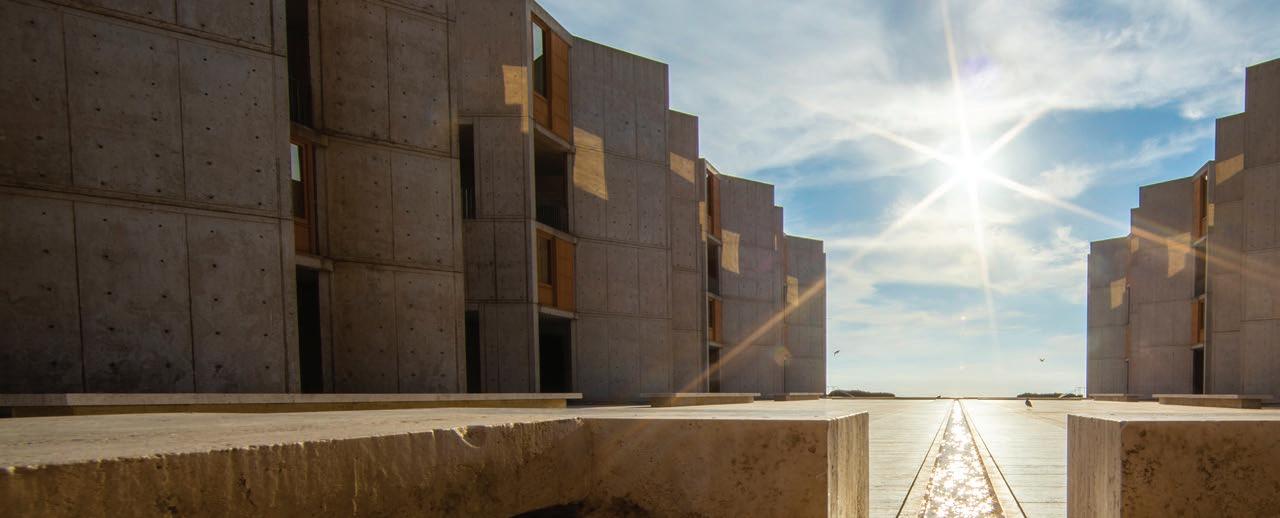
clearly at the forefront of neuroscience research, and the family extended our support to the Institute with the hope that researchers are able to find the next breakthrough with MS.”
The research project will be broken up into four consecutive studies headed by four Salk labs. Evans will oversee the project and investigate the role bile acids play in MS, as well as explore how special formulations of vitamin D might block disease progression; Associate Professor Ye Zheng will look at the potential to treat MS using modified mRNA vaccine technology; Associate Professor Axel Nimmerjahn will study whether it is possible to control the inflammatory response in MS through glial cells; and Professor Susan Kaech will test whether blocking the hypoxia-inflammation cycle in MS will lead to effective new treatments. The hypoxiainflammation cycle is a condition in which low oxygen levels (hypoxia) increase inflammation, and inflammation in turn triggers hypoxia. The cycle is thought to play a role in MS progression.
Collectively, the team will undertake a multidisciplinary approach to understanding the association between hypoxia, loss of healthy gut regulation, and MS. The team also hopes to successfully attract additional support from government and private philanthropy.
“The Salk team is exploring new therapeutics that bypass complications from diet and sun exposure to produce a totally novel approach to quench neuronal inflammation to ease and potentially erase MS pathology,” says Evans, director of the Gene Expression Laboratory and holder of the March of Dimes Chair in Molecular and Developmental Biology. “With novel molecular, genetic, immunologic, and neuroimaging technologies, we aim to transform our new discoveries and technologies into new therapeutics for patients.”
you to our generous supporters
The Salk Institute will receive a total of $1.25 million for neuroscience research and the new Joan and Irwin Jacobs Science and Technology Center, thanks to two generous gifts from the Jay and Sarah Flatley Foundation.

“We are delighted by the support the Flatley Foundation and Jay have shown the Institute over many years, and most recently with these two gifts,” says Salk President and Professor Rusty Gage. “Their generosity will go a long way in helping us reach the goals of Salk’s fundraising Campaign and strengthening our scientific efforts moving forward.”
Salk’s Campaign for Discovery was launched in 2019 with the aim of attracting the people and building the technology and space necessary to accelerate research in six critical areas: neuroscience, cancer, aging, plant biology, immunobiology, and computational biology. As part of the Campaign, the Institute plans to build the new Jacobs Center on the east side of campus. The 100,000-square-foot facility will provide much-needed research and administrative space to advance and expand the Institute’s scientific mission, in keeping with founder Jonas Salk’s vision of flexible and functional design that enables collaboration and exploration.
Construction of the Jacobs Center will also allow for the reallocation of space in Salk’s current facilities and creation of a Center of Excellence for Neuroscience.
Neuroscience research has long been a strength at Salk, giving rise to fundamental discoveries in brain development, movement, sensation, learning, memory,
and neurodegenerative diseases. Salk scientists are now studying how some brains adapt well to the myriad of daily stresses that can challenge our mental health and how other brains don’t, and what tips the balance between acute and chronic mental health issues.
Empowered by the Flatley Foundation gift and the Campaign for Discovery, the Center of Excellence will co-locate and expand many Salk neuroscience labs, providing a “think tank” for cell biologists, geneticists, behavioral scientists, computational biologists, and other experts all tackling the same research questions from different perspectives with the goal of pursuing novel treatments and diagnostics.
Each of the two Flatley Foundation gifts is in the amount of $500,000. The donation toward the new building was matched by longtime Salk supporters Joan and Irwin Jacobs as part of the couple’s $2 to $1 grant challenge, increasing the Flatley Foundation’s building gift to $750,000, for a total donation of $1.25 million.
“Exciting things are happening at Salk, and our foundation saw a wonderful opportunity to help accelerate the future of scientific discovery at the Institute,” says Jay Flatley, a Salk Trustee and former CEO and Chairman of Illumina.

The Jay and Sarah Flatley Foundation gives $1.25 million to Salk’s neuroscience research and campus expansion
“Salk is clearly at the forefront of neuroscience research, and the family extended our support to the Institute with the hope that researchers are able to find the next breakthrough with MS.”
BENJAMIN LEWIS Salk TrusteeFrom left: Jay and Sarah Flatley.
The Salk Institute is grateful to have received $64 million in donations so far this year—more than double the amount raised at this point the previous year.
As an architectural engineering student at California Polytechnic State University in San Luis Obispo, Leona Flores found herself captivated by the design potential of concrete. In one of her classes, she first learned about the renowned architect Louis Kahn and the Salk Institute. She convinced her dad to take her to San Diego to see the architectural landmark during her senior year.
“I had studied the design of the Salk Institute, but it was a totally different experience to see it in person,” says Flores. “Never did I imagine that I would be the executive director of the Institute’s Cancer Center so many years later.”
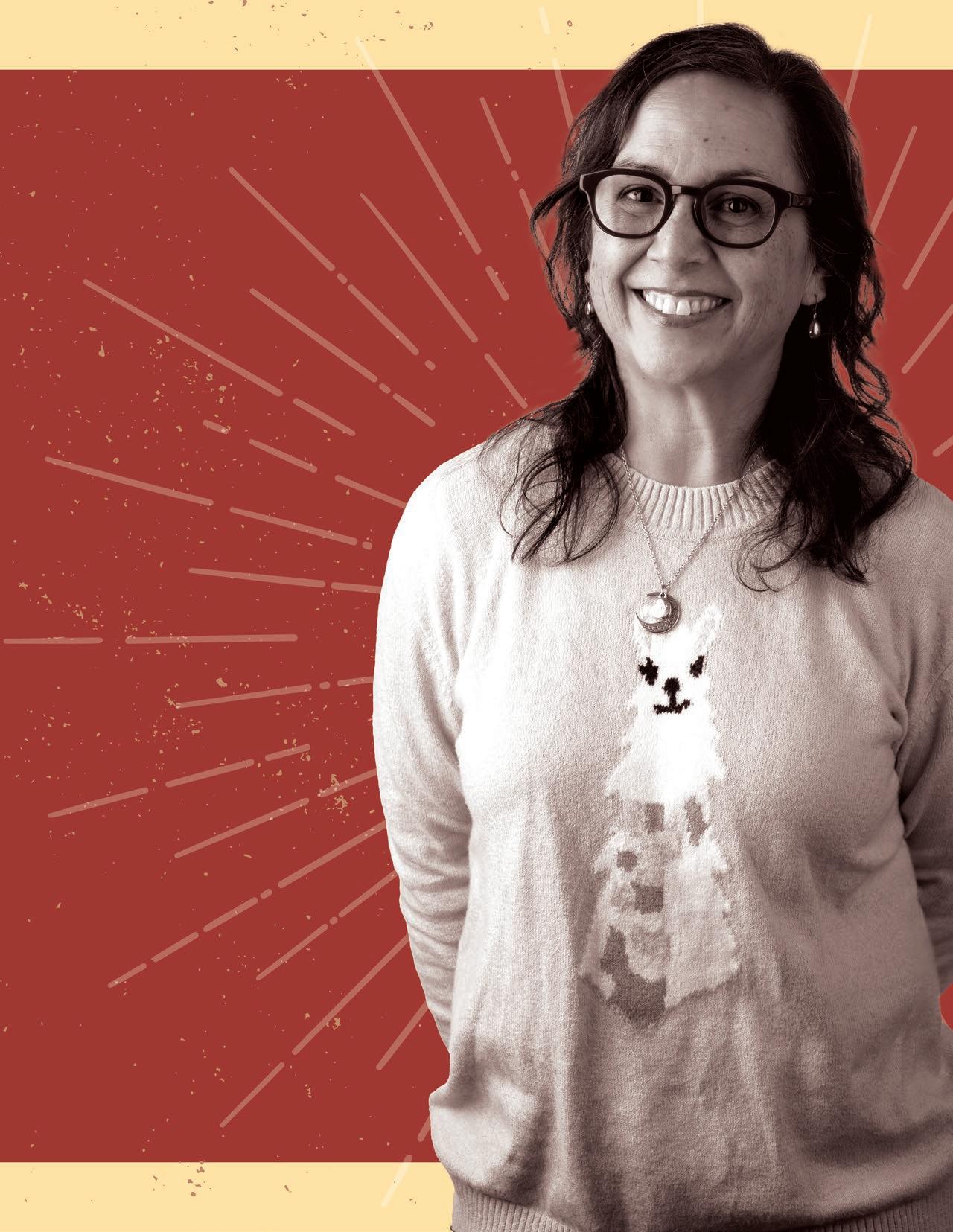
Flores was born in the United States island territory of Guam, but raised in Huntington Beach and Laguna Niguel, California, when her father was transferred to the Naval Base San Diego. She came from a large family with three brothers and more than 50 first cousins. “Guam is the westernmost US territory and closest to the International Date Line, so we like to say that Guam is where America’s day begins,” says Flores. “A lot of my family still lives there.”
Flores loved math and architecture, so she became a civil engineer and later worked in structural engineering for more than 10 years. Although she enjoyed being an engineer, she felt a pull toward science and medicine. So, she cut back on her job and enrolled in community college to pursue premedical studies. She later took a job at the Orange County coroner’s office, where she worked as a forensic technician.
“I completed more than 3,000 autopsies and worked closely with the pathologists,” says Flores. “Everything I was learning in school, anatomy and physiology, was right there on the table in front of me.”
This role eventually turned into a position at Children’s Health of Orange County (CHOC), where Flores worked for a physician who headed the then NICHD Brain and Tissue Bank for Developmental Disorders. She also had the opportunity to work in his molecular biology lab, which sparked her interest in pursuing a PhD instead of an MD.
After she completed her bachelor’s in biological science at California State University, Fullerton, Flores was accepted to UC San Diego for her PhD in biomedical engineering. She also completed her postdoctoral fellowship at UC San Diego, but she didn’t want to pursue academia. Instead, she became an associate editor for the American Association for Cancer Research, where she worked under the director of the UC San Diego Moores Cancer Center.
This role morphed into scientific administration, and she started to get involved with developing scientific presentations, writing grants, and establishing interdisciplinary collaborations as director for research development and collaborations at Moores Cancer Center. In 2020, she was recruited by Professor Reuben Shaw to be the executive director of the Cancer Center at Salk. “Besides the exceptional science that I knew happened at Salk, I couldn’t believe I was going to work at the architectural landmark I once aahed over as an engineering student,” says Flores. “Talk about full circle!”
Flores spends her day organizing meetings, symposia, and retreats, as well as finding new opportunities for trainees. Her goal is to raise the Cancer Center’s profile within the scientific community and among granting agencies. She also works on grants, including a more than 1,000-page renewal to allow Salk to keep the title of National Cancer Institute (NCI)Designated Cancer Center. Being NCI-designated means that the Cancer Center conducts groundbreaking research focused on developing new approaches for preventing, diagnosing, and treating cancer.
“Having this designation is the gold standard of cancer centers. When you’re NCI-designated, you have a seat at the table with organizations that direct patient care,” says Flores. “Our discoveries set the foundation for the development of effective therapeutics.”
“While Salk does not directly participate in many clinical studies, our work still comes down to helping people. I know this because my brother passed away from chronic lymphocytic leukemia three years ago,” says Flores. “When it transformed into a more aggressive cancer, I wished he had had more treatment options. I know that Salk is where I need to be to support researchers in making scientific discoveries that could turn into effective therapeutics.”
Riding and Rocking for Research
Flores is an avid cyclist and is passionate about supporting Padres Pedal the Cause hosted by Curebound. The cycling event, which began in 2013 and takes place around every spring, raises money for six local cancer research organizations, including Salk’s Cancer Center. Since it began, Salk scientists have been awarded more than $1.25 million in pilot grants.
“Pedal the Cause is such an amazing event, because the money truly does go directly to fund local cancer research,” says Flores.
This year, Flores joined a group of local oncologists who all enjoy playing music in their not-so-free time. She plays keyboard and drums with her band, aptly named Adverse Events, at various venues for cancer-related gigs. “We’re not great, but we’re not awful,” laughs Flores.

Flores recognizes that successful cancer research depends on training the next generation of scientists. She organizes training opportunities so that young researchers can hear talks from physicians and other scientists, as well as meet the people affected by these conditions. “It’s important for us all to remember why we’re doing what we’re doing,” says Flores. “Our trainees need to see the impact they’re making as well as understand how much further we still have to go.”
Leona is an unstoppable force who has helped us transform the infrastructure of the Cancer Center. She is the real deal, a triple threat of scientific expertise, grants expertise, and managerial capability.”
PROFESSOR REUBEN SHAW Director of Salk’s Cancer Center

Postdoctoral Researcher Payel Mondal grew up in the metropolitan city of Kolkata, India, where she learned to speak Bengali, Hindi, and English fluently. Her family would take regular trips to the Indian Museum to gaze at enormous dinosaur skeletons and ancient fossils. In the winter, they would venture to the annual flower shows, where Mondal enjoyed learning the scientific names of the rare orchids, cacti, and other flowering plants.
From a young age, Mondal’s mind was captivated by the beauty and elegance of the natural world.
Although her parents were not scientists, she fell in love with biochemistry during high school. Her school had a small chemistry lab where she mixed common ingredients together to create bright colors and fumes. But to pursue science in India, she needed more than curiosity and passion—she also needed to perform well on the standardized tests.

Mondal enlisted the help of a tutor and worked tirelessly to prepare for the highly competitive exams. She was elated to

learn that she had scored well and was admitted to the prestigious Indian Institute of Technology in Kharagpur to study biotechnology.
“During my degree, I realized that a PhD offered the most opportunities in science,” says Mondal. “So, I started looking at schools that had strong programs in biochemistry and molecular biology.”
The University of Illinois Urbana-Champaign stood out to her, and, upon graduating from the Indian Institute of Technology, Mondal gave up the temperate climate of India for snow in a country she had never stepped foot in before. Although she initially studied chromosome biology, she soon switched to focusing on optogenetics, a technique that uses light-sensitive proteins to control cellular activity. “Optogenetics is a relatively simple technique with complex applications,” says Mondal. “I was excited by how I could use optogenetics to better understand cell signaling pathways.”
When her husband moved to Purdue University, she followed and completed her first postdoctoral fellowship, studying enzymes called phosphatases involved in cancer. But she dreamed of conducting science at the Salk Institute and was thrilled to join Assistant Professor Christina Towers’ lab to study the mechanisms involved in cancer progression for her second postdoctoral fellowship.
“The level of collaboration at Salk is high compared to other institutions, and Christie is such an amazing mentor,” says Mondal. “Her lab felt like a place where I could thrive, and her research is an area I was excited to explore.”
In the Towers lab, Mondal wants to learn more about why some patients respond well to cancer therapeutics at first, but then relapse. Some cancers can recycle their own nutrients and power-generating structures, called mitochondria, to evade cancer drugs. This recycling process is called autophagy, and Mondal aims to uncover new autophagy biomarkers that can spur the development of more-effective cancer treatments.
“I am passionate about cancer research because there is a strong correlation between research and application,” says Mondal. “The projects we’re working on in the lab will likely be translated into therapeutics to help people someday. That prospect really excites me.”

Since joining Salk in 2020, Mondal has received two Institute awards. She was recognized with the Salk Women & Science Research Award, which helps fund early-career scientists’ innovative research proposals, as well as the Pioneer Fund Postdoctoral Scholar Award, which provides $75,000 in funding to young scientists. “Salk is unique in that it has so many awards for young scientists,” says Mondal. “It keeps us excited and makes our work more visible.”
Outside of science, Mondal loves to travel to tropical areas and visits Hawaii whenever she can. The Big Island and Maui are two of her favorite spots, but you won’t see her reading a romance novel on the beach anytime soon. Instead, Mondal prefers soaking in everything she can about financial stability, investing, and retirement saving. “I enjoy strategizing about my personal financial goals,” chuckles Mondal. “I am now much more aware of how I can plan for my financial future.”
After Salk she hopes to join a local biotechnology company, where she can run her own research group in cancer therapeutics. “I want to see something I work on help cancer patients in my lifetime. That is my goal,” says Mondal.
I am passionate about cancer research because there is a strong correlation between research and application. The projects we’re working on in the lab will likely be translated into therapeutics to help people someday. That prospect really excites me.”
PAYEL MONDAL Postdoctoral Researcher


An affinity group network launched at the Salk Institute in 2020 with the founding of two groups: the Black Association at Salk (BAS) and Underrepresented Minorities Actively Supporting Excellence (URMase). The network soon added two more groups: Asian Pacific Islander and Desi at Salk (APIDAS) and the Salk Pride Society (SPS).
Affinity groups enhance wellbeing and strengthen the Salk culture by uniting trainees and employees from particular identities and allies of diverse backgrounds. The groups provide a platform to discuss, understand, and define the interests of its members and their shared experiences at the Institute and in the community.
Each group has a unique focus and mission, but all share a commitment to enriching life at Salk. The groups operate under the guidance of the Institute’s Diversity,

Equity & Inclusion team, in particular Program Manager Lauren Mitchell.
“I’m so proud of the positive impact our affinity groups are having on the campus experience,” Mitchell says. “They are a forum for practicing solidarity and seeking understanding. I’ve been inspired by how passionately members of our community embrace and support these groups.”
The affinity groups have played a crucial role in bringing members of the Institute together in a spirit of inclusion, deeper understanding, and educational celebrations, like Juneteenth, Día de los Muertos, and Lunar New Year, which were celebrated campus-wide.
Each group is in charge of defining its mission and identifying opportunities that celebrate our campus population and promote increasing diversity in alignment with Salk’s scientific mission.
Examples of such activities include an interactive session hosted by URMase and the Institute’s Grants Development office last fall, which featured Marguerite Matthews, National Institute of Neurological Disorders and Stroke program director, who began her own
scientific journey as a high school summer intern at Salk. Matthews spoke on maximizing government funding opportunities—a workshop called “Demystifying Diversity Supplements.”
And in February, BAS hosted numerous on-campus educational and interactive activities in recognition and support of Black History Month, including a first of its kind “Black in STEM” panel discussion, which brought together outstanding researchers from Black in Cancer, Black in Immuno, and Black in Neuro to discuss the issues faced by Black researchers and the critical work of these organizations.
“The affinity groups are grassroots in nature and reflect the broad interest on campus in participating in the Institute’s commitment to diversity, equity, inclusion, and belonging,” says Mallory Zaslav, vice president of Diversity, Equity & Inclusion. “Myriad identities are part of the Salk culture. By coming together to recognize, involve, and educate our campus community about our colleagues, each group is actively building the future of Salk. The outreach they do and inspire in others is a testament to our collective responsibility as part of this organization to be good ancestors.”



 Left: APIDAS members celebrating Lunar New Year at Salk. Below: Lunar New Year (left) and Día de los Muertos (right) celebrated at Salk.
Left: APIDAS members celebrating Lunar New Year at Salk. Below: Lunar New Year (left) and Día de los Muertos (right) celebrated at Salk.
Professor Thomas
,
teamed
design experts at the Los Angeles County Museum

curators

study how nearly 100,000 museum visitors respond to exhibition design. The goal of the project is to better understand how people perceive, make choices in, interact with, and learn from a complex environment, and to further enhance the educational mission of museums through evidence-based design strategies. The exhibition—“Conversing in Clay: Ceramics from the LACMA Collection”—is open until May 21, 2023.
Art
From left: Zoe Kahr, Eric Leonardis, Talmo Pereira, Sergei Gepshtein, Thomas Albright, Victoria Behner, and Catherine Massey. Credit: Courtesy of Museum Associates/LACMA




 Motion capture technology is used to classify human behavior in an art exhibition.
From left: Eric Leonardis and Talmo Pereira capturing the geometry of the room to create a digital model of the exhibition.
Credit: Courtesy of Museum Associates/LACMA
Motion capture technology is used to classify human behavior in an art exhibition.
From left: Eric Leonardis and Talmo Pereira capturing the geometry of the room to create a digital model of the exhibition.
Credit: Courtesy of Museum Associates/LACMA
“LACMA is one of the world’s greatest art museums, so it is wonderful to be able to combine its expertise with our knowledge of brain function and behavior. The beauty of this project is that it extends our laboratory research on perception, memory, and decision-making into the real world.”
PROFESSOR THOMAS ALBRIGHT


The San Diego Nathan Shock Center, directed by Professor Gerald Shadel, received new funding from the National Institutes of Health (NIH) to enroll participants from the Rancho Bernardo Study of Healthy Aging into their own clinical cohort to study cellular differences in how individuals age. Initiated 50 years ago, the Rancho Bernardo Study is one of the longest, continuously NIH-funded studies in existence.

“What makes this venture so unique is that we’re now accessing cells from older adults with a documented history of normal aging metrics, which will allow aging researchers to connect specific cellular changes to other age-related physiological changes for the first time.”
PROFESSOR GERALD SHADEL




American Cancer Society Professor Tony Hunter, Professor Reuben Shaw, and Assistant Professor Graham McVicker were among 12 inaugural 2022 Discovery Grant winners. The awards, which total $3 million, were launched last year by Curebound, a philanthropic organization dedicated to funding collaborative cancer research that has the potential to reach patients. Salk’s three collaborative projects include examining genetic mutations in pediatric cancer testing new therapeutics for patients with pancreatic ductal adenocarcinoma, and targeting potential new breast cancer therapeutics.
The Institute welcomed Assistant Professor Deepshika Ramanan to the faculty. Ramanan is an innovative researcher studying how the maternal immune system changes during pregnancy and breastfeeding and affects immunity and inflammation in babies across multiple generations. Her lab, part of Salk’s NOMIS Center for Immunobiology and Microbial Pathogenesis, opened in March 2023.
 DEEPSHIKA RAMANAN
TONY HUNTER REUBEN SHAW
DEEPSHIKA RAMANAN
TONY HUNTER REUBEN SHAW
Professors Joseph Ecker, Ronald Evans, Rusty Gage, Christian Metallo, Satchin Panda, Reuben Shaw, and Kay Tye, along with Assistant Professor Jesse Dixon, were named to the Highly Cited Researchers list by Clarivate. The list identifies researchers who demonstrate “significant influence in their chosen field or fields through the publication of multiple highly cited papers.” Additionally, Professor Joanne Chory and Professor Emerita Catherine Rivier were named among the 1,000 Best Female Scientists in the World, an inaugural ranking by Research.com that celebrates the contributions of women in science. Evans and Gage were also ranked in the top 100 Best Scientists in the World, an inaugural ranking also by Research.com that identifies leading experts in specific fields of research.

JOHN REYNOLDS NAMED 2022 AAAS FELLOW

Professor John Reynolds was named a 2022 Fellow of the American Association for the Advancement of Science (AAAS). Reynolds is among more than 500 new AAAS Fellows who were nominated by their peers for their distinguished efforts to advance science. He and his team use computational modeling and a variety of other techniques to study the brain mechanisms involved in perception and conscious awareness.

TEN SALK PROFESSORS NAMED AMONG BEST AND MOST HIGHLY CITED RESEARCHERS IN THE WORLDJOHN REYNOLDS
Chester, founder of the Linda Chester Literary Agency, died at her home in La Jolla, California, on December 9, 2022. She was 76. At the Salk Institute, Chester served as International Council liaison from 2007 to 2009 and as member of the Board of Trustees from 2009 to 2015. She was very committed to Salk Women & Science, serving on the program’s advisory board, and she often attended Symphony at Salk.



Taneashia Morrell, a senior contracts and licensing associate in Salk’s Office of Technology Development, will oversee two of the group’s four major DEI committees—the Anti-Racism Committee and the Dialogue on Diversity Committee—for 2023.
Charlotte Rambla, a postdoctoral fellow in the lab of Professor Wolfgang Busch, was awarded the 2022 Jeanie Borlaug Laube Women in Triticum Early-Career Award by the Borlaug Global Rust Initiative, a program that provides professional development opportunities for female wheat researchers in the early stages of their career in recognition of scientific excellence and leadership potential.
 LINDA CHESTER
CHARLOTTE RAMBLA RECEIVES
JEANIE BORLAUG LAUBE WOMEN IN TRITICUM EARLY-CAREER AWARD
CHARLOTTE RAMBLA
TANEASHIA MORRELL
LINDA CHESTER
CHARLOTTE RAMBLA RECEIVES
JEANIE BORLAUG LAUBE WOMEN IN TRITICUM EARLY-CAREER AWARD
CHARLOTTE RAMBLA
TANEASHIA MORRELL
Associate Professor Eiman Azim was awarded $100,000 to study how social isolation, anxiety, and depression affect movement. The Local Initiative For Excellence (L.I.F.E.) Foundation supports research to achieve better health outcomes for patients with brain and neurodegenerative diseases. His team explores how the brain controls movement of the body, focusing on dexterous behaviors, such as grasping a cup of coffee or catching a ball.

In the study, published July 20, 2022, in Nature, Professor Kay Tye and team discovered the molecule in the brain responsible for associating good or bad feelings with a memory. The finding paves the way for a better understanding of why some people are more likely to retain negative emotions than positive ones—as can occur with anxiety, depression, or posttraumatic stress disorder (PTSD).



Nuttida Rungratsameetaweemana, a postdoctoral fellow in the lab of Professor Terrence Sejnowski, was selected as one of the 2022 Rising Stars in Engineering in Health, a program co-hosted by Johns Hopkins Biomedical Engineering and Columbia University to educate, train, and empower emerging leaders in academia at the intersection of engineering and biomedicine.


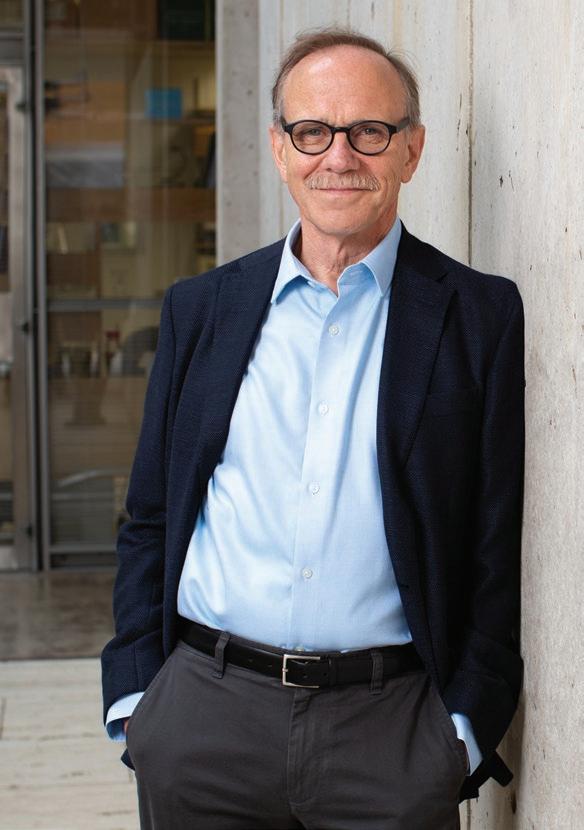
 Salk President Rusty Gage was featured in the 2022 edition of the SD 500, the San Diego Business Journal’s annual list of San Diego County’s most influential business leaders. A leading neuroscientist, Gage directed the Salk Institute for five years.
Salk President Rusty Gage was featured in the 2022 edition of the SD 500, the San Diego Business Journal’s annual list of San Diego County’s most influential business leaders. A leading neuroscientist, Gage directed the Salk Institute for five years.
President Rusty Gage named one of San Diego’s “Most Influential Business Leaders”NUTTIDA RUNGRATSAMEETAWEEMANA RUSTY GAGE NUTTIDA RUNGRATSAMEETAWEEMANA NAMED 2022 RISING STAR IN ENGINEERING IN HEALTH
The Salk Institute and the March of Dimes have a rich history of collaboration. The partnership began in 1948 when the March of Dimes (then known as the National Foundation for Infantile Paralysis) provided support for Jonas Salk’s quest for a vaccine against polio. The organization also provided the funding that enabled him to fulfill his vision to create the Salk Institute in 1960.
In 1990, as the Salk Institute planned for its 30th anniversary, Jonas Salk was eager to give back to the community, promote scientific literacy, and encourage young people to choose life science careers. To accomplish these goals, he launched High School Science Day.
On February 25, 2023, we celebrated the collaboration between the March of Dimes and the Salk Institute with the 33rd annual March of Dimes High School Science Day event, generously supported by the Anne and Neal Blue High School Science Fund.
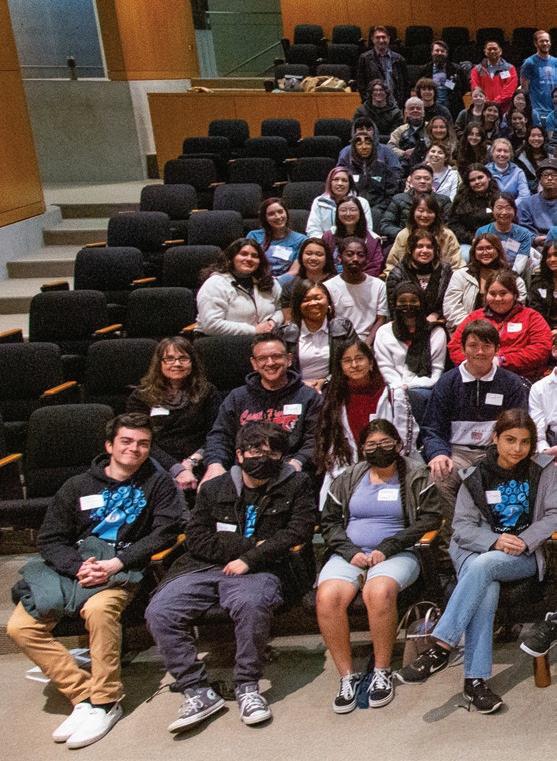
During the half-day event, 160 high school students and their teachers participated in interactive lab tours, where they met scientists, heard about current research, and learned hands-on fundamental skills necessary for laboratory research, such as micropipetting.

Of the students who attended, 86 percent identified with a historically underrepresented community; 60 percent qualify for free or reduced-price school lunches; and 85 percent said they were more interested in STEM careers after attending. One student commented that the most impactful part of the day was “talking with scientists and realizing that they have so many different backgrounds but the same passion—it inspires me.”
The event, organized by Salk’s Education Outreach team, was held in person after two years of remote programming, but creative virtual content is still available to teachers in order to maintain accessibility to fundamental research and unique educational opportunities.
To learn more about this event and other Education Outreach opportunities, please visit www.salk.edu/education-outreach





Please join us for the launch of Salk’s Science & Justice series. During this inaugural event, neuroscientist and Professor Thomas Albright will join Peter Neufeld, civil rights lawyer and co-founder of The Innocence Project, to discuss the latest research on visual perception and memory, how that influences forensic identification decisions, and what that means for justice in our criminal legal system.
Through an engaging moderated discussion, the speakers will break down the topics above based on their respective areas of expertise and collaborations and explore how a modern scientific understanding of visual perception and memory can help to overcome failures of forensic practice and guide courts toward greater justice.
Members of the public and individuals involved professionally in criminal law, scientific research, public policy, and social justice, who follow and/or await developments in this realm will have a unique opportunity to learn more about the intersection and contradictions between science and law during this event.
A reception will follow the discussion.
For more information, please visit www.salk.edu/justice


Join us for another spectacular “Concert Under the Stars,” the annual Symphony at Salk on August 19, 2023. This acclaimed concert and fundraiser held on Salk’s iconic Courtyard will feature an electrifying performance by the San Diego Symphony with a special guest artist. For more information, please visit symphony.salk.edu or contact us at symphony@salk.edu or (858) 597–0657

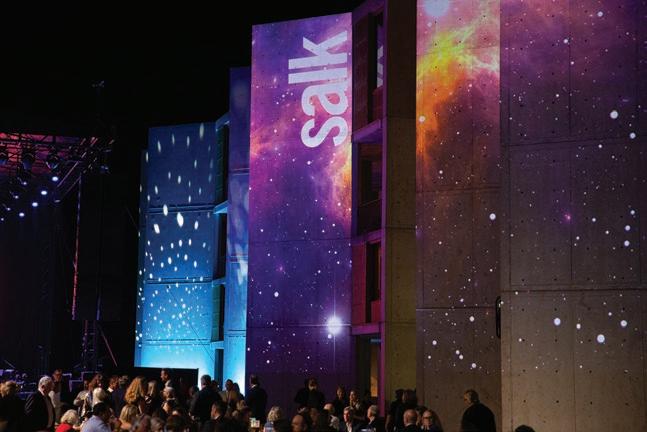
The Campaign for Discovery is the Salk Institute’s seven-year, $750 million comprehensive fundraising campaign. The goal is to attract the people and build the technology and space necessary for innovation in six critical areas: cancer, healthy aging, plant biology, immunobiology, neuroscience, and computational biology.

As part of the campaign, we plan to build the new 100,000-square-foot Joan and Irwin Jacobs Science and Technology Center on the east side of our iconic campus.
Science is a collaborative pursuit, and we invite you to join us in accelerating life-changing discoveries: www.salk.edu/campaign
